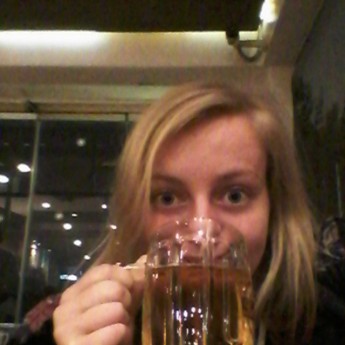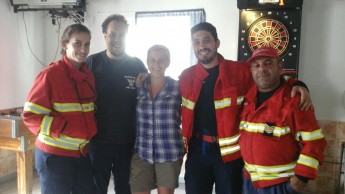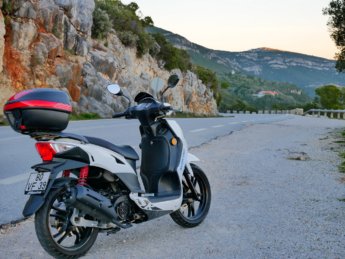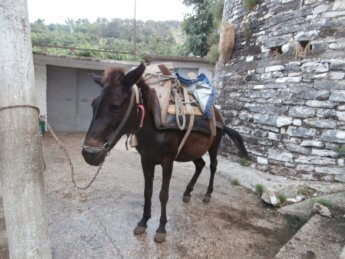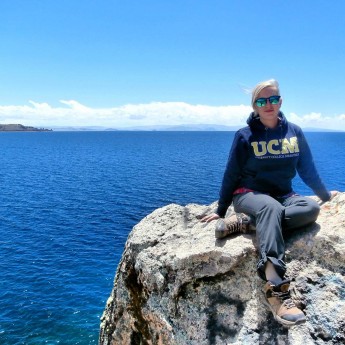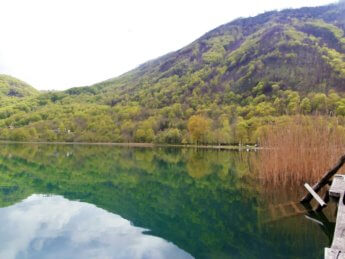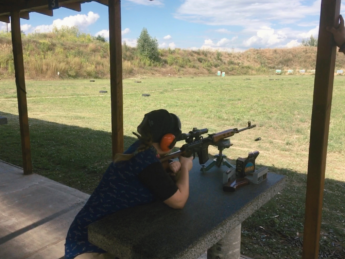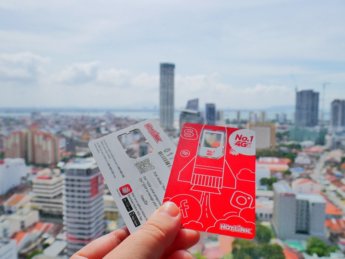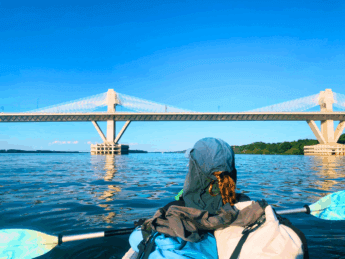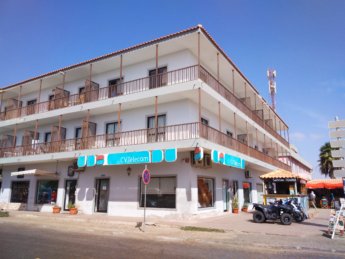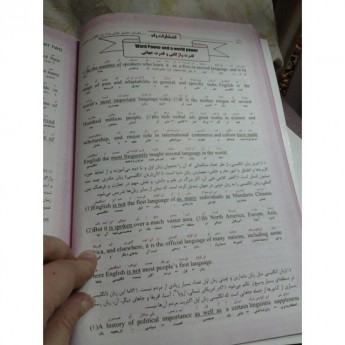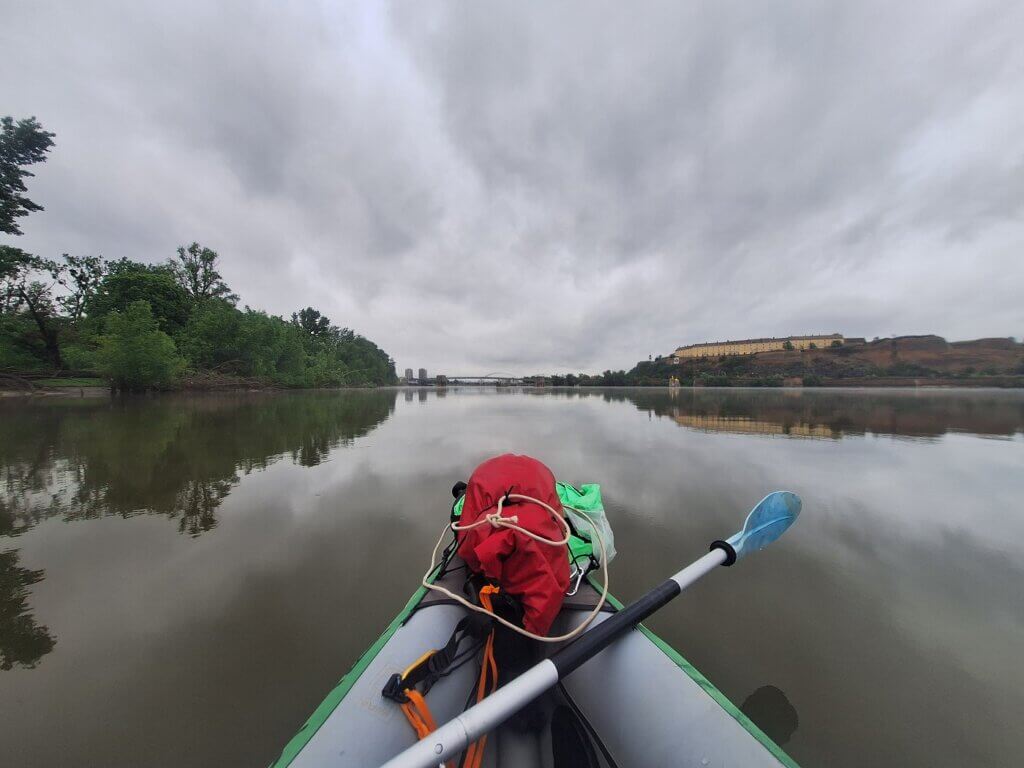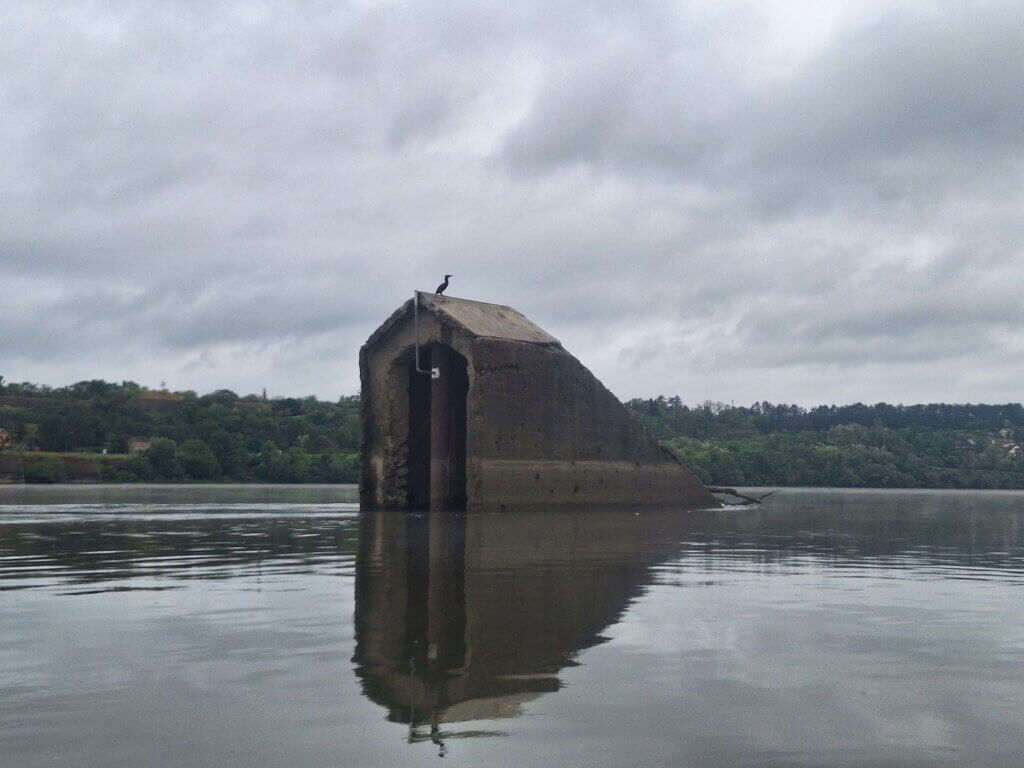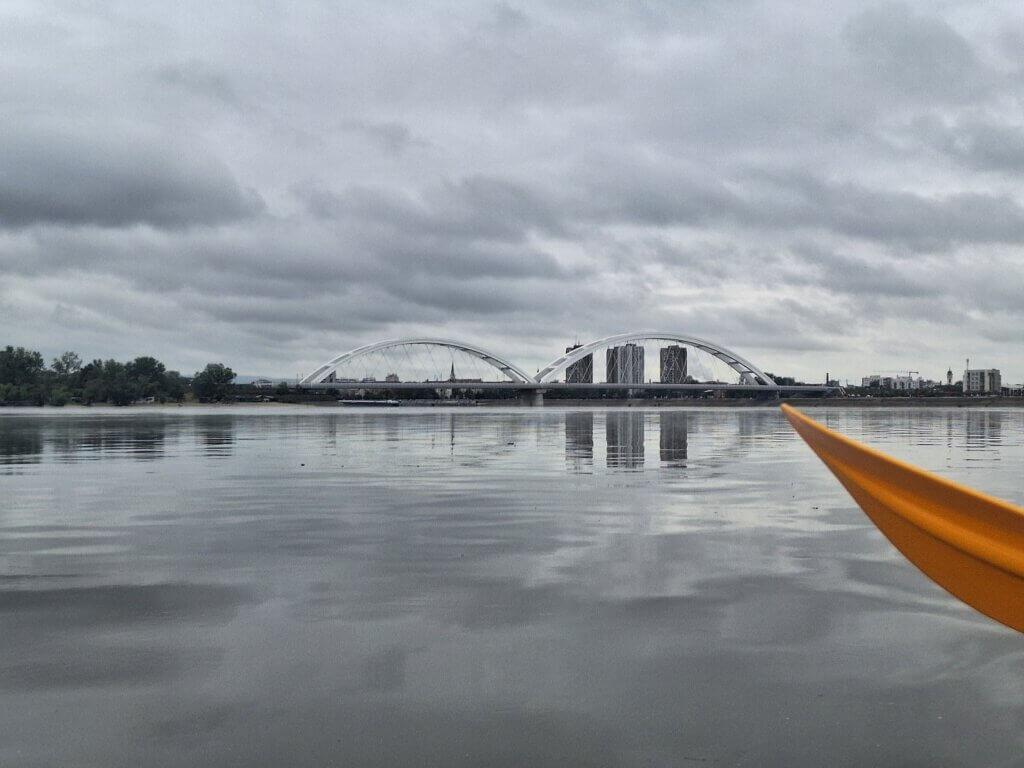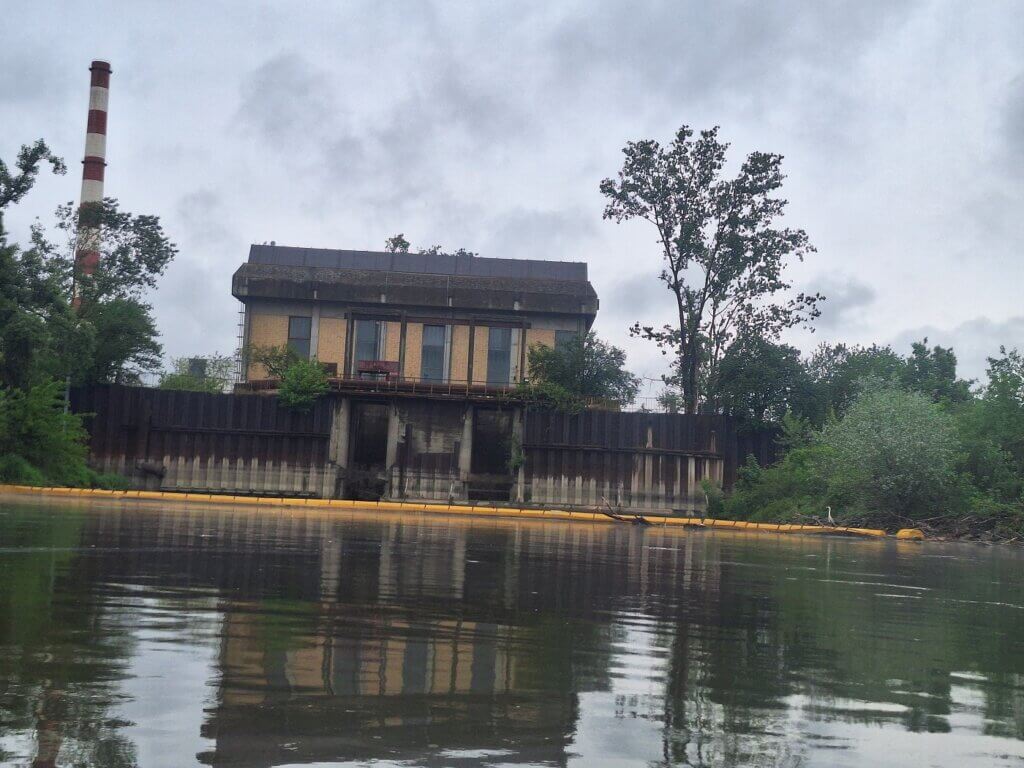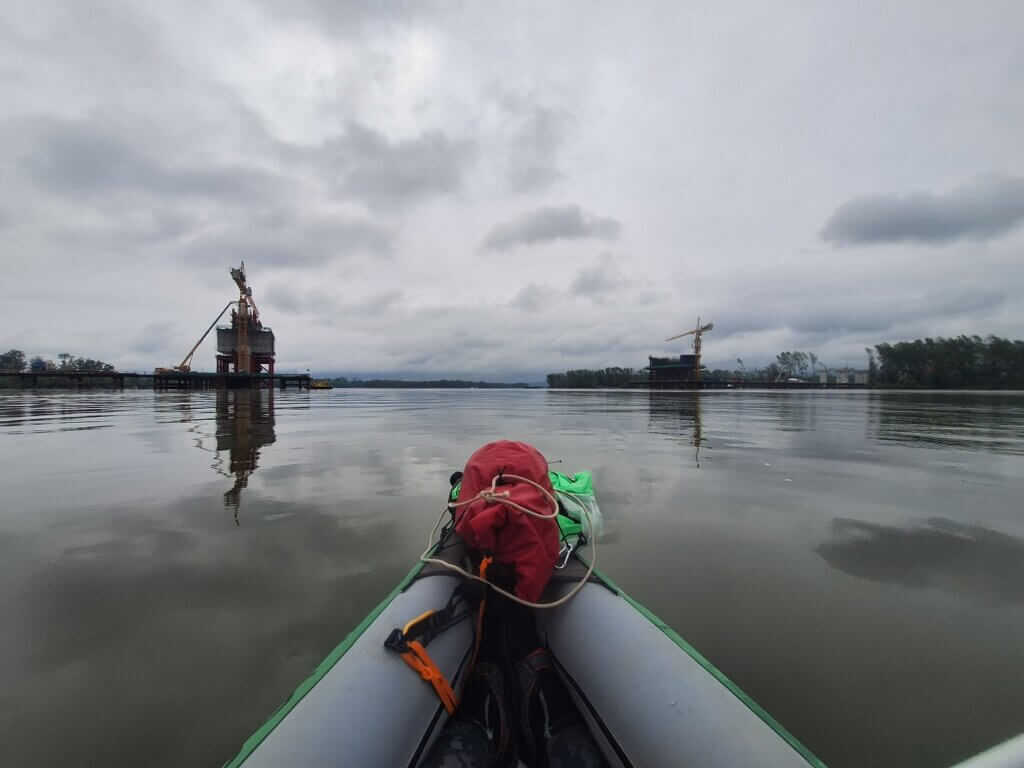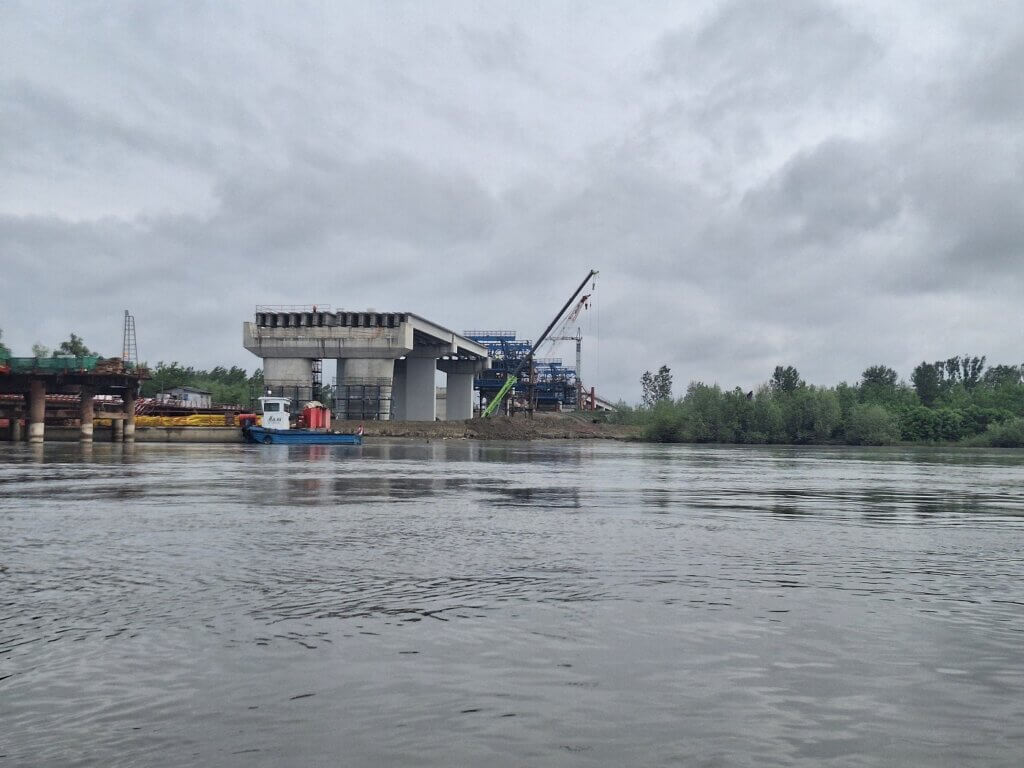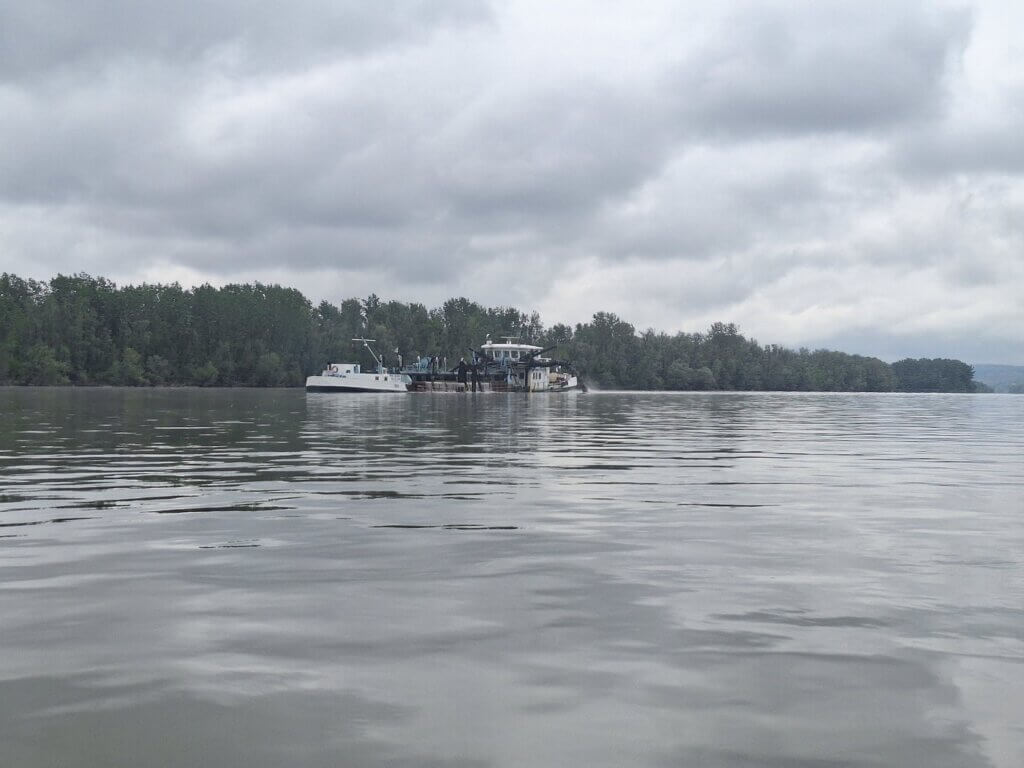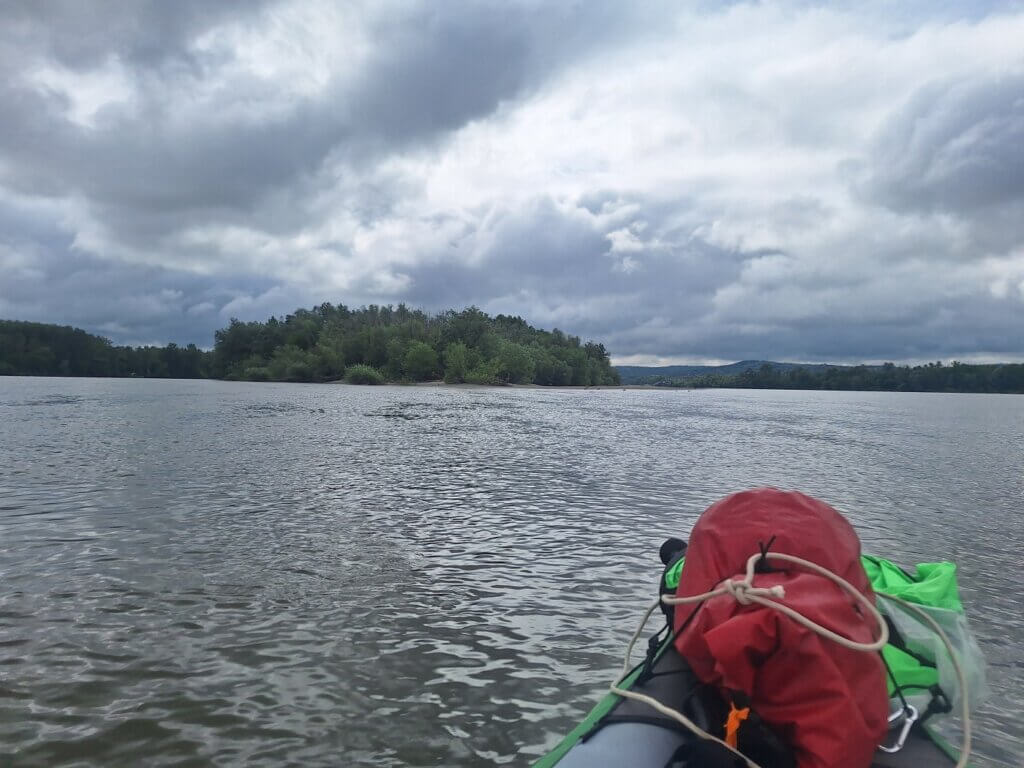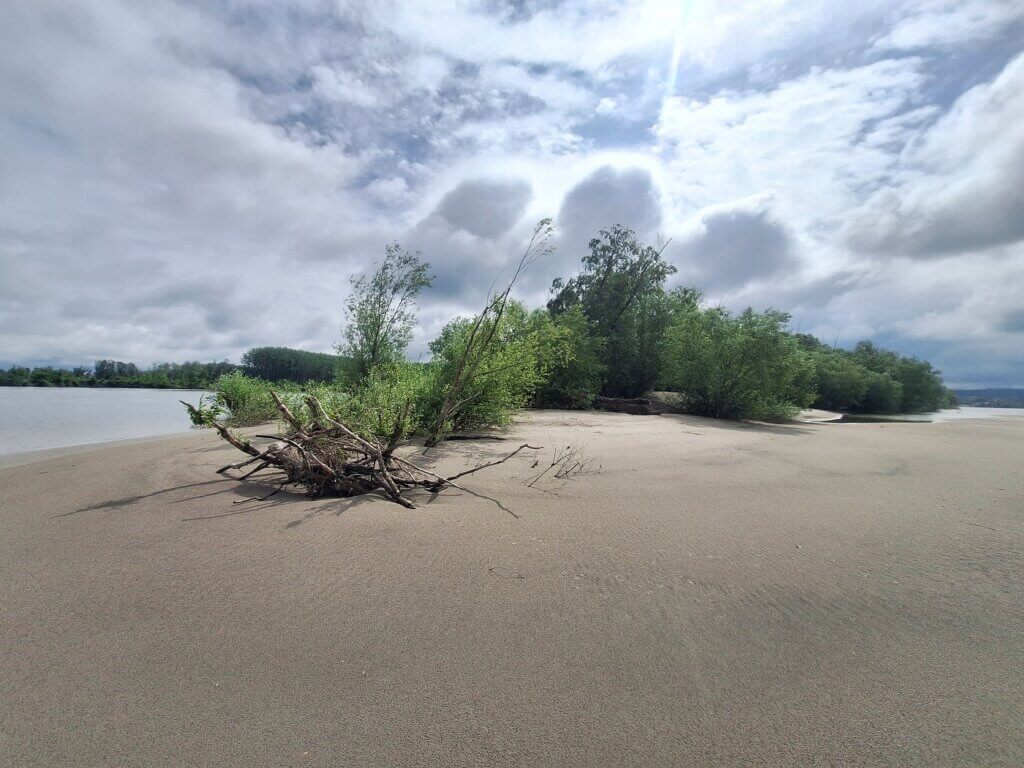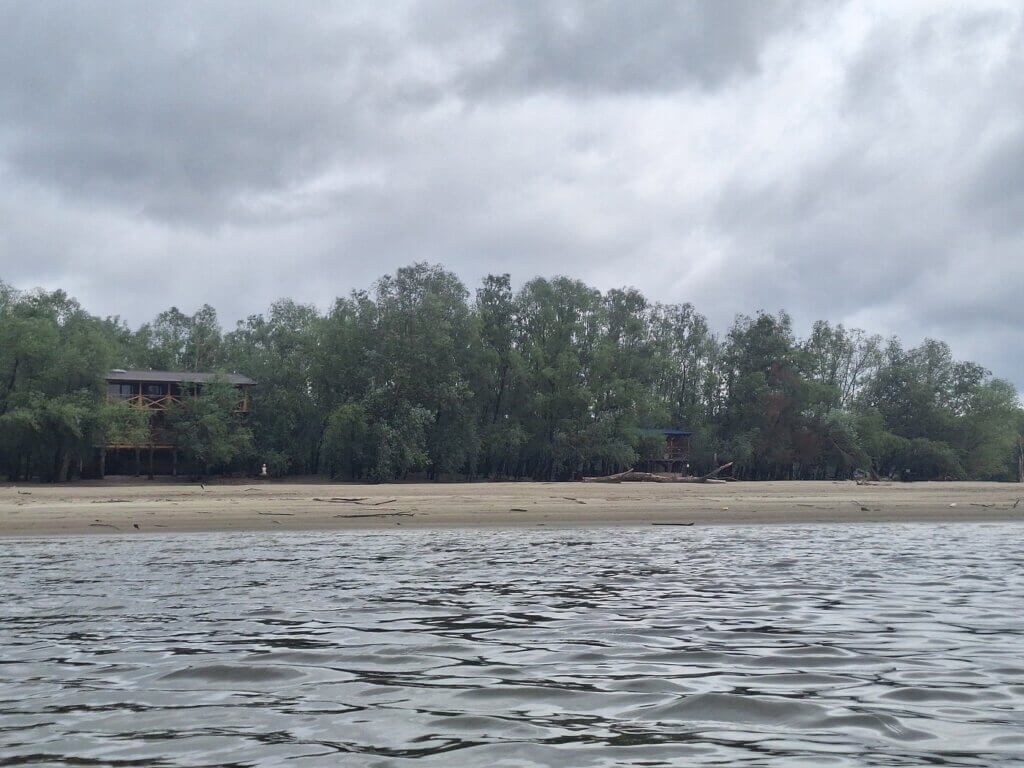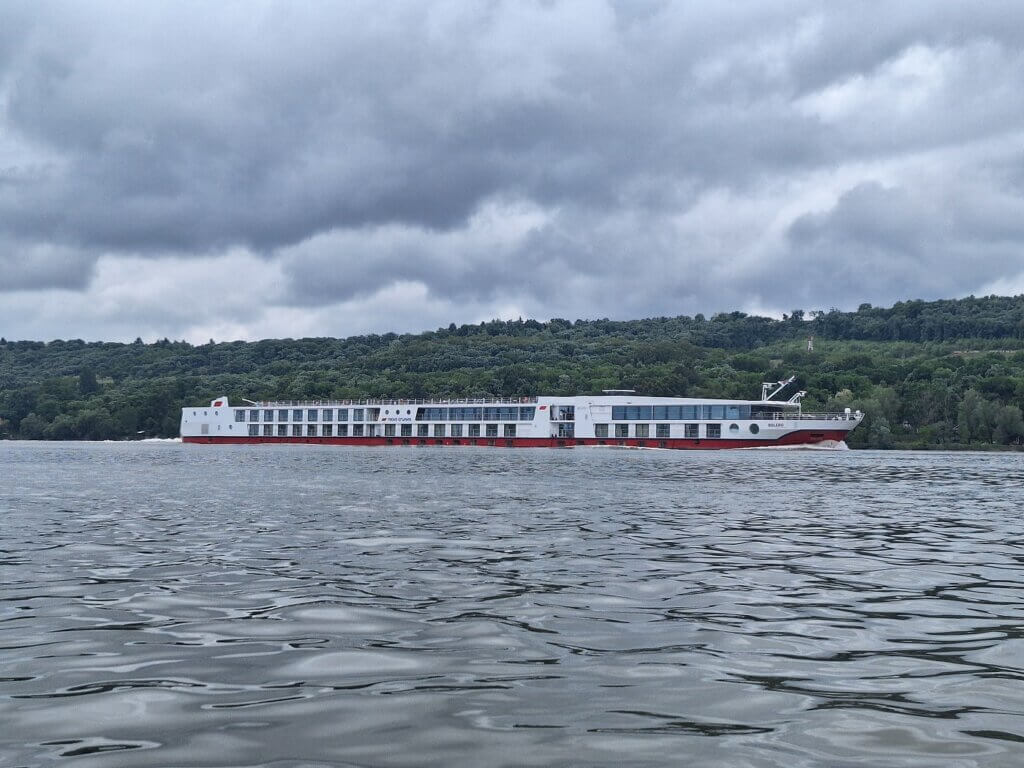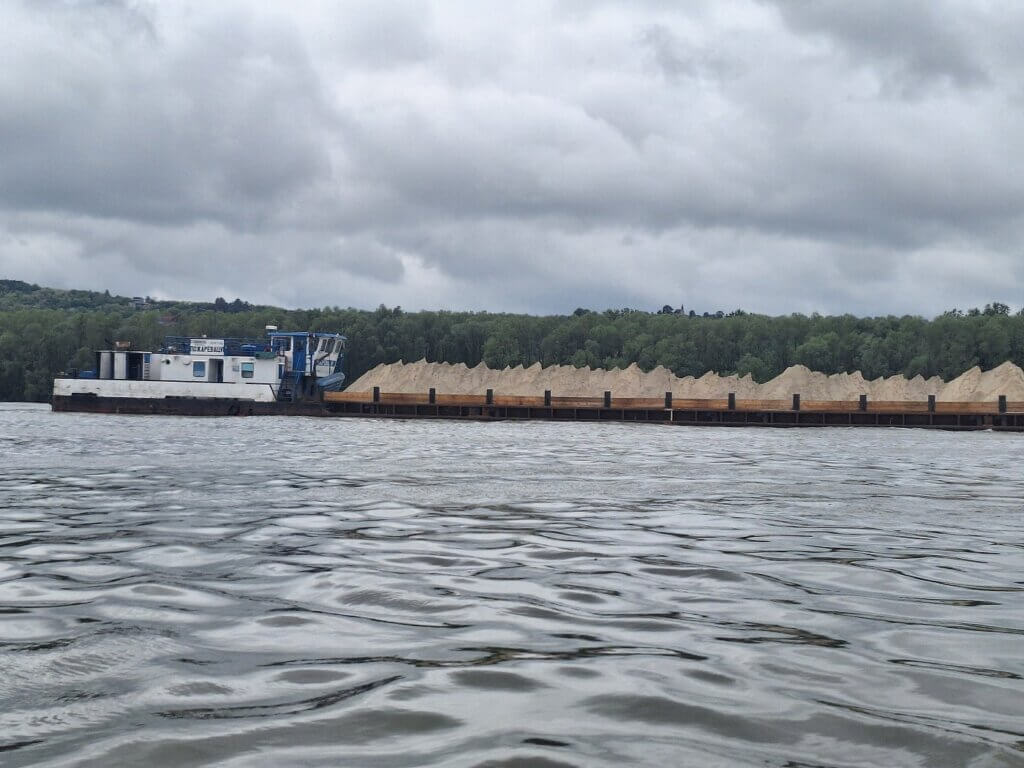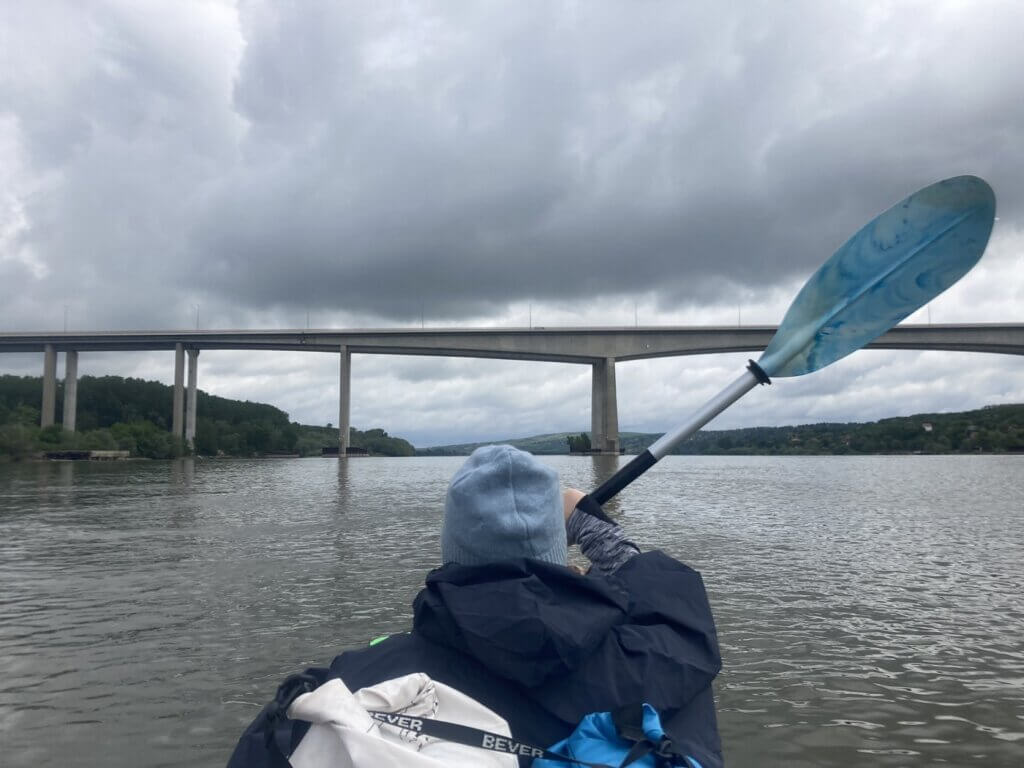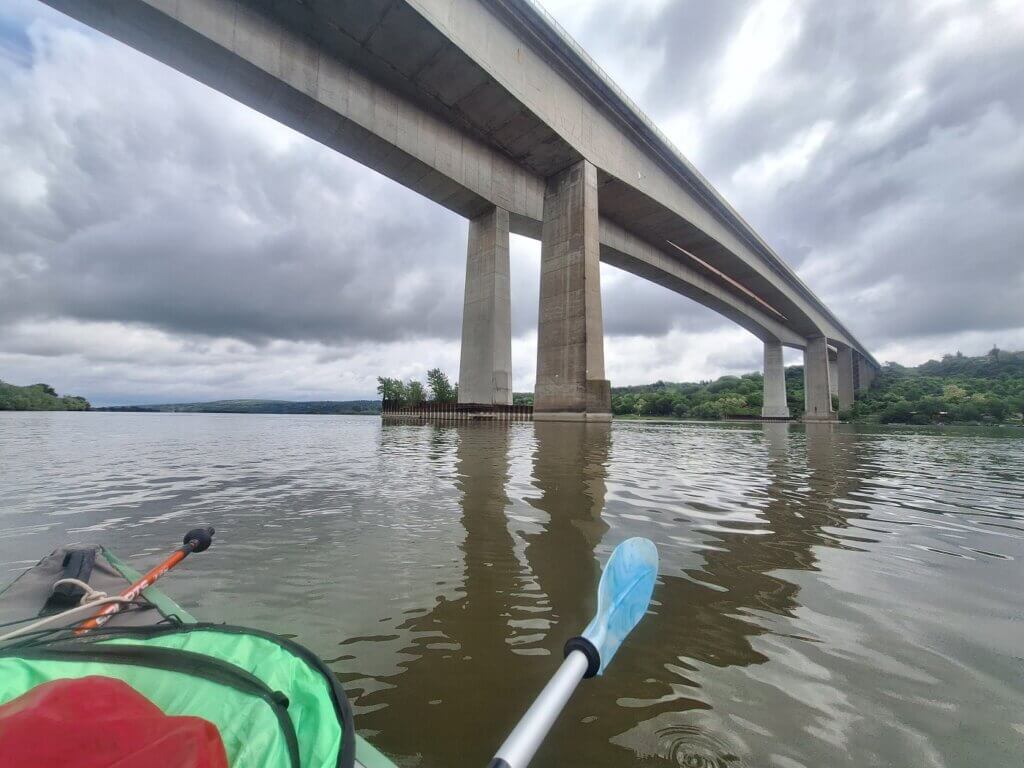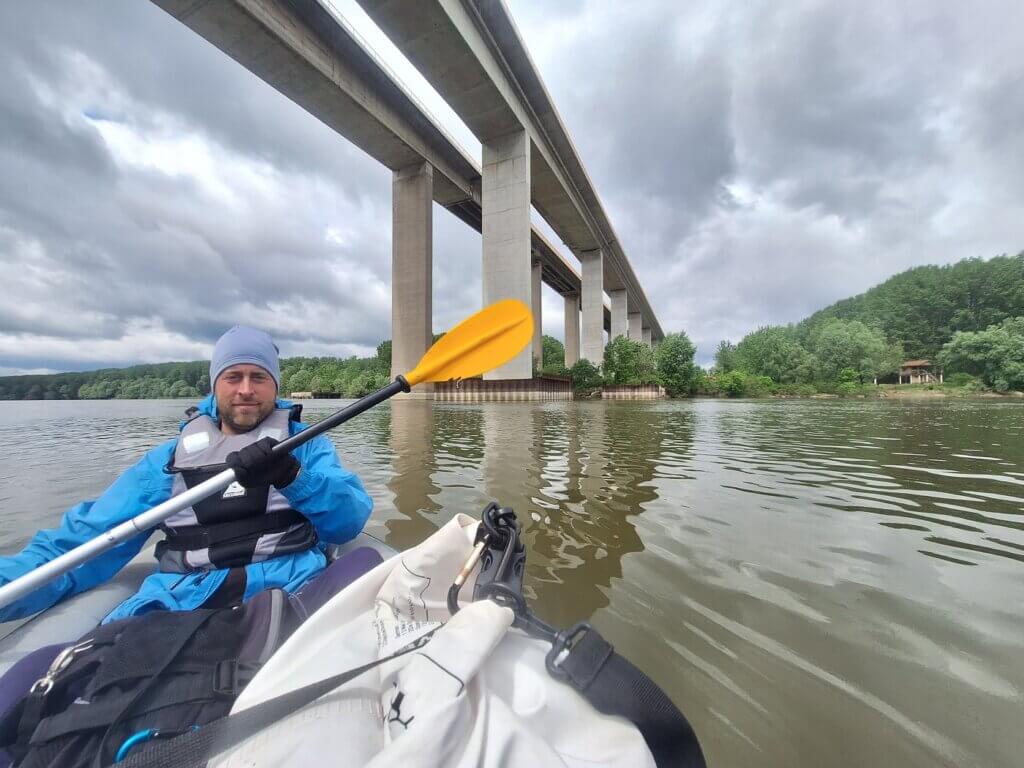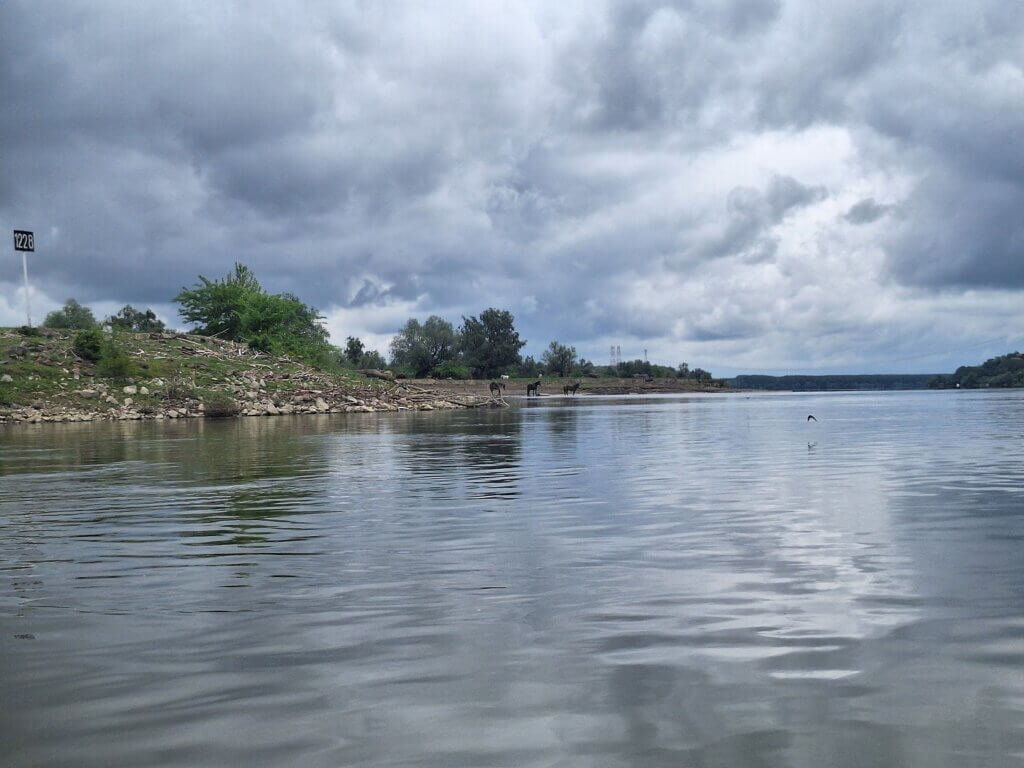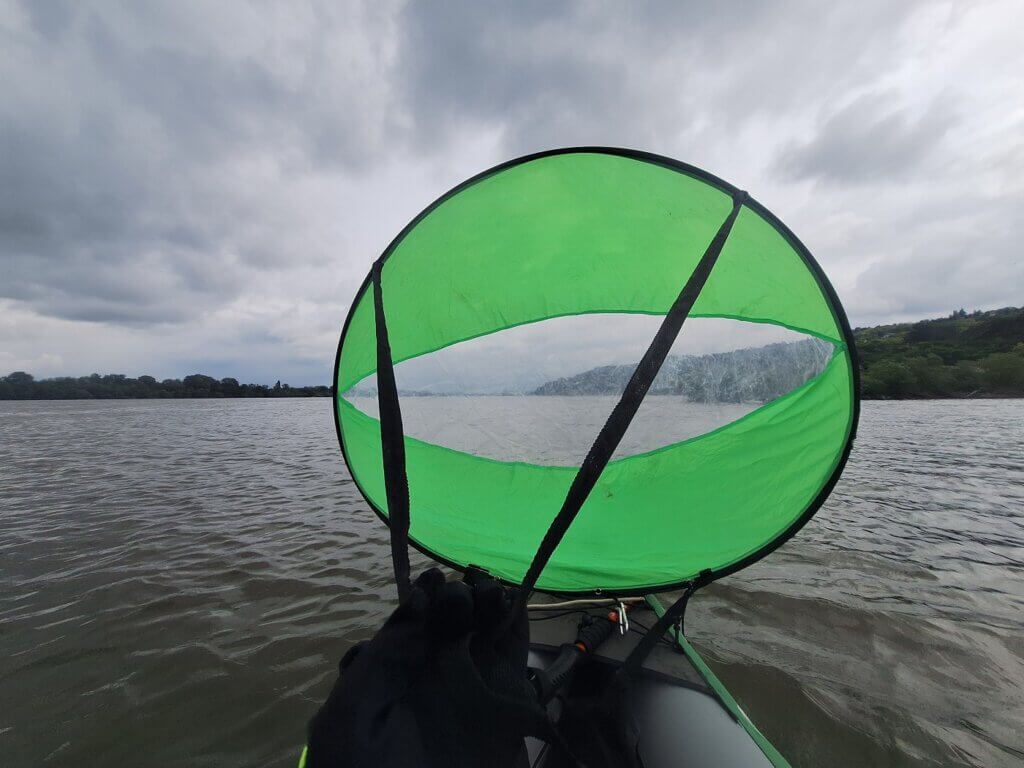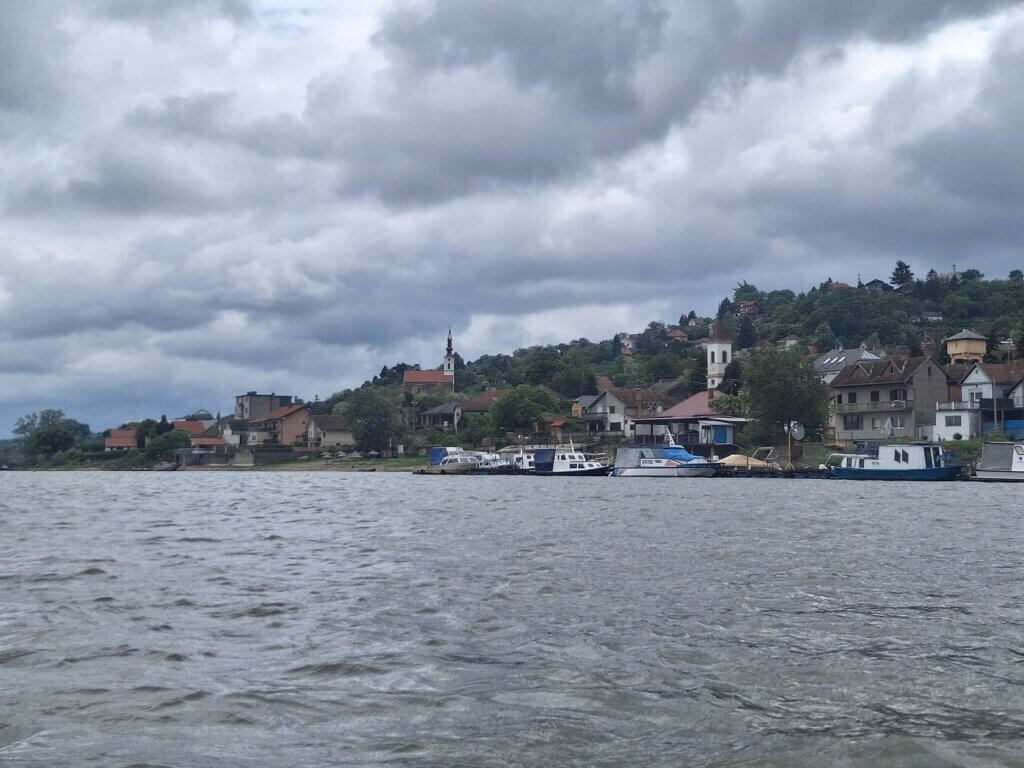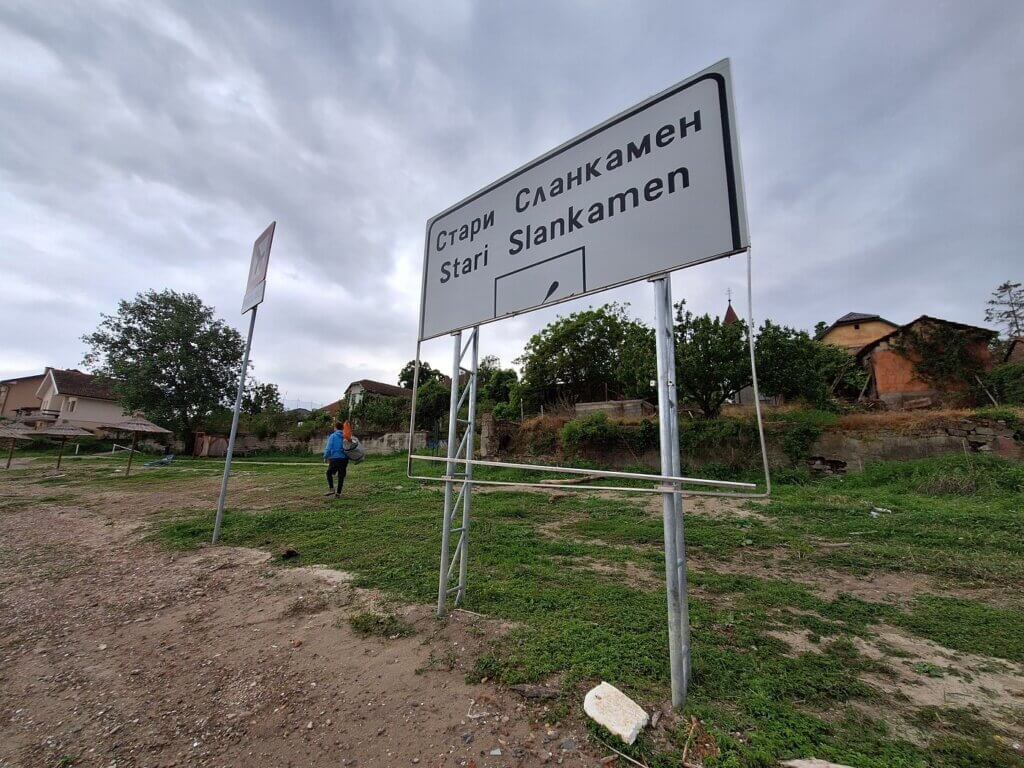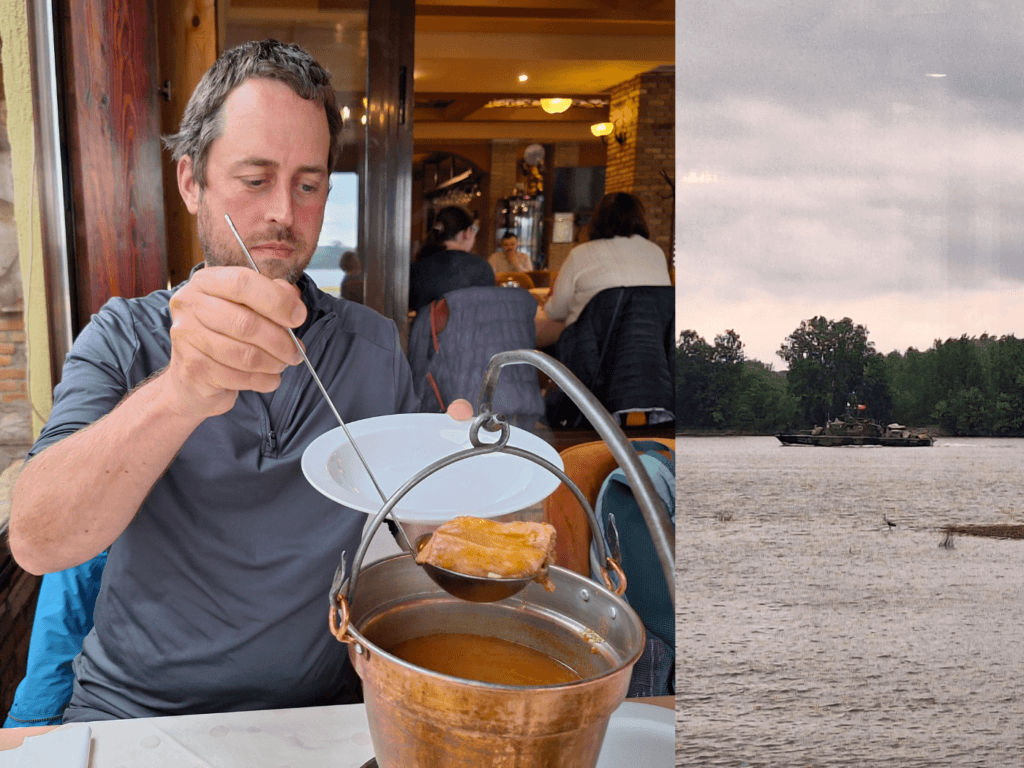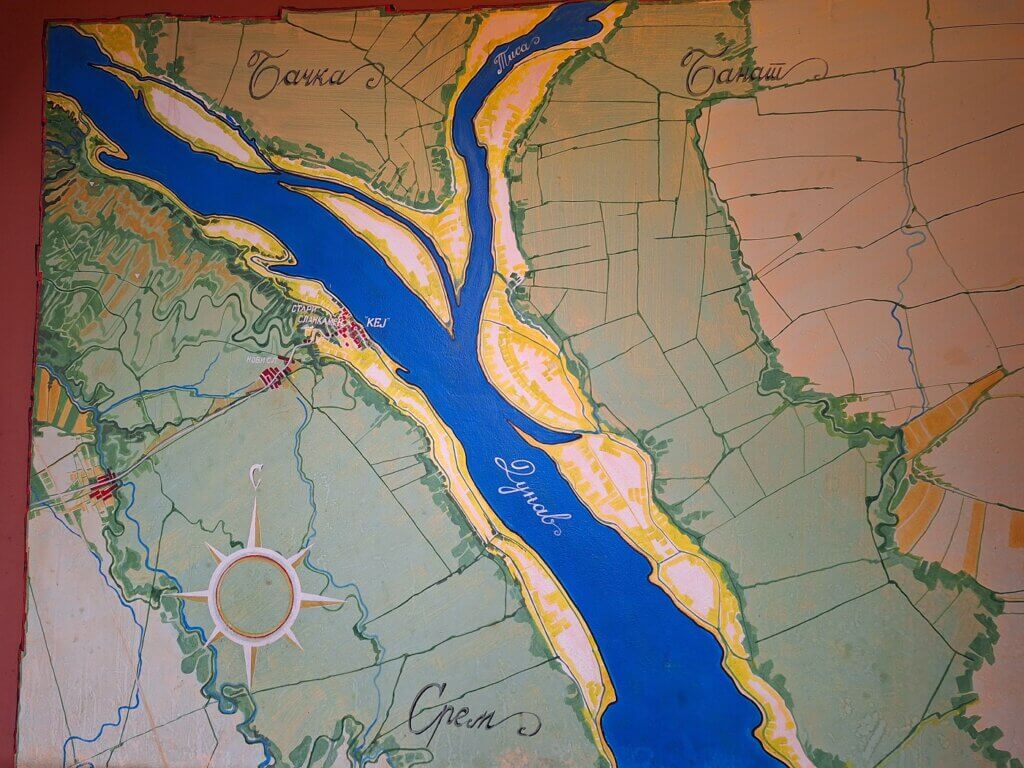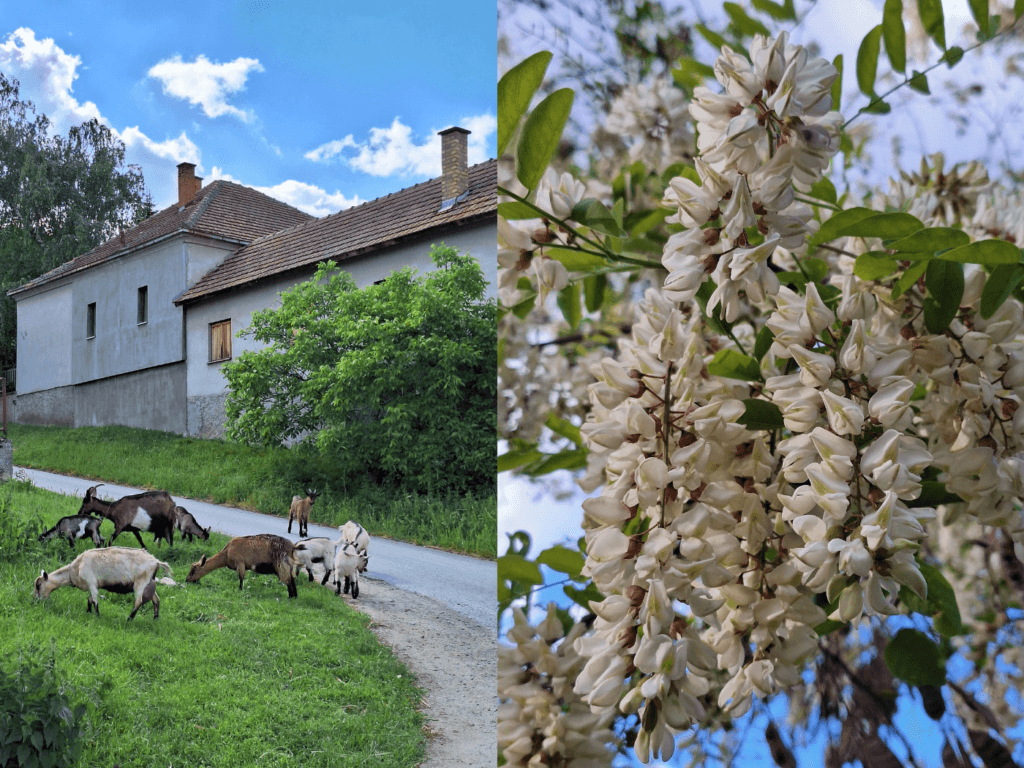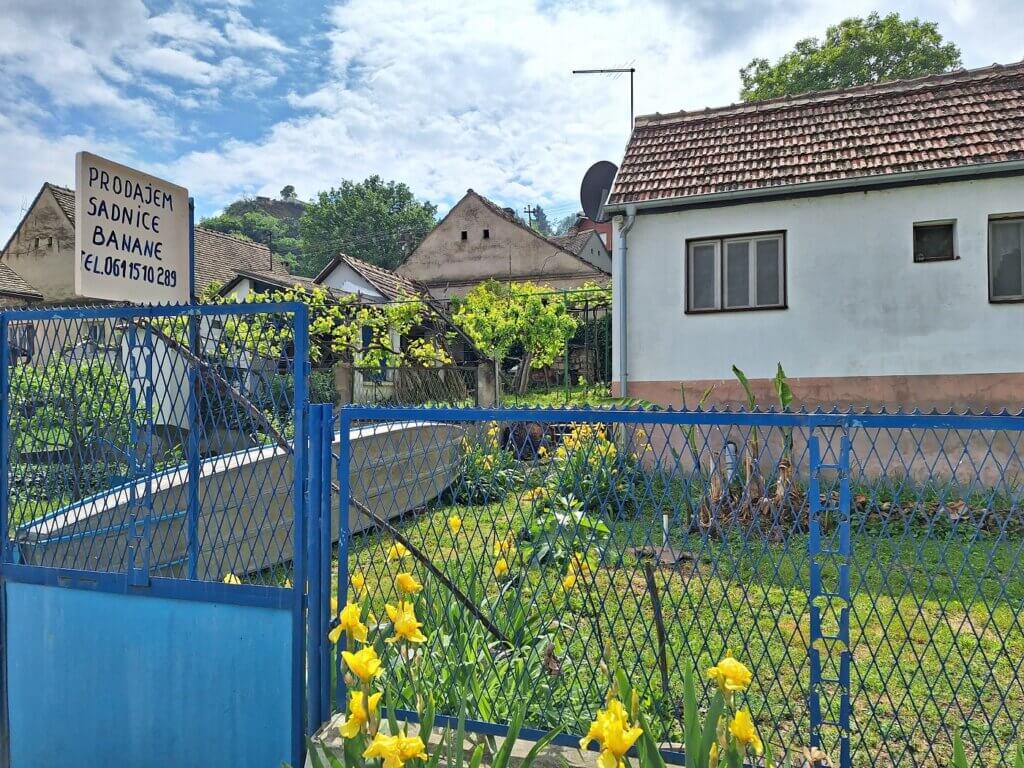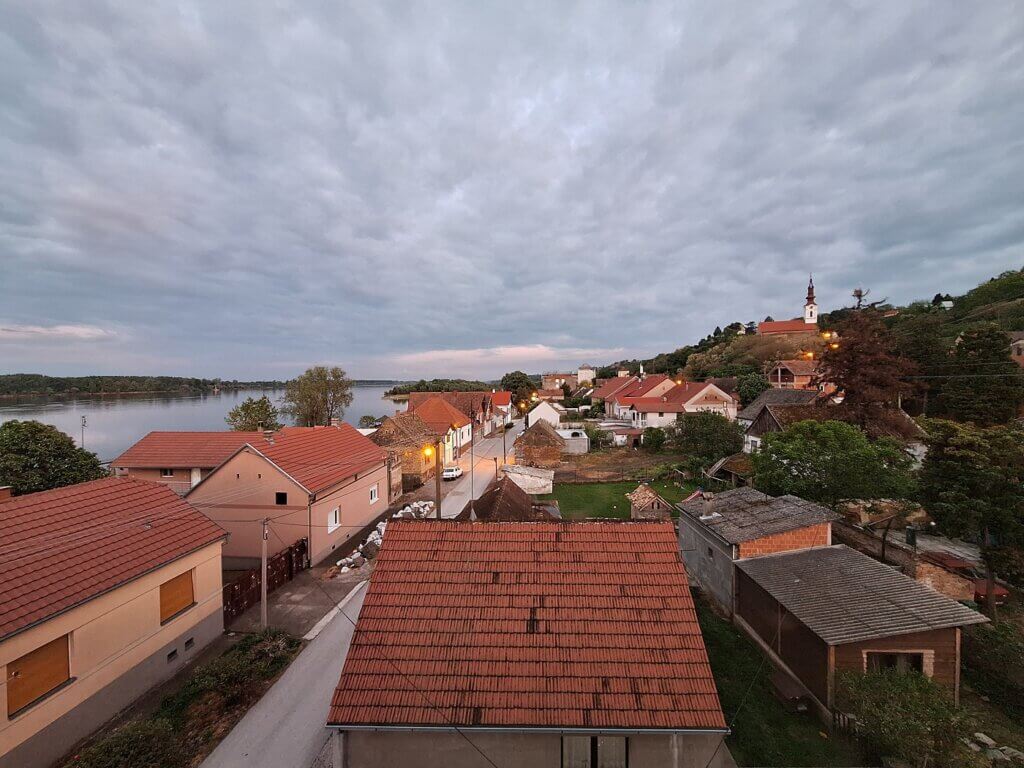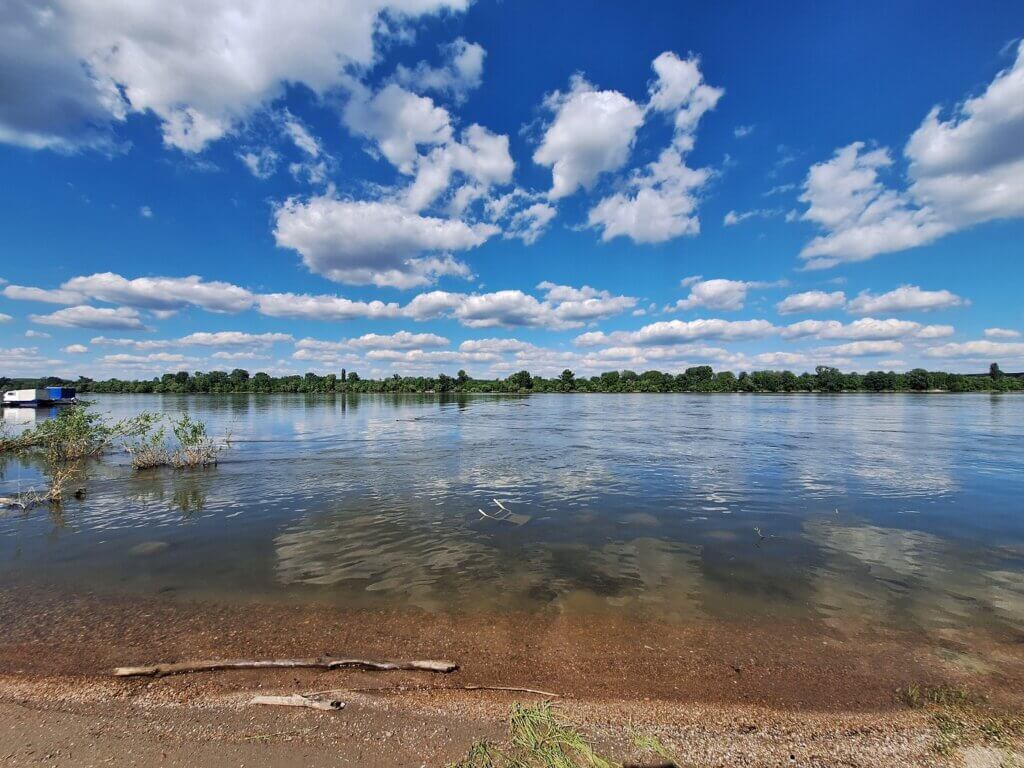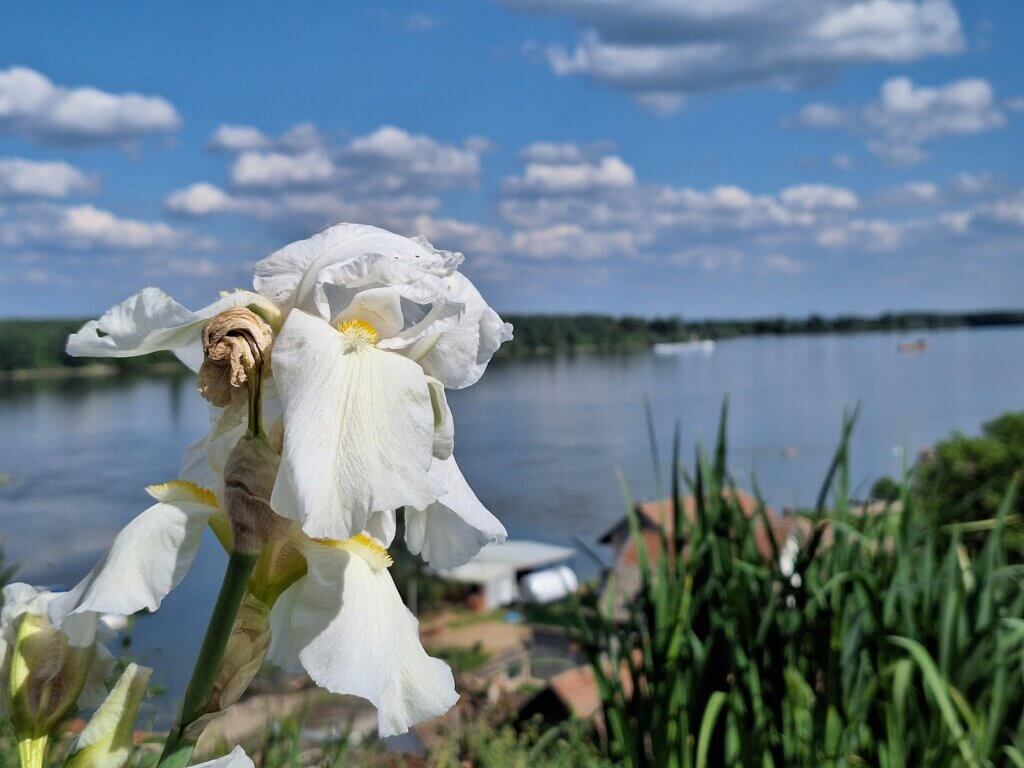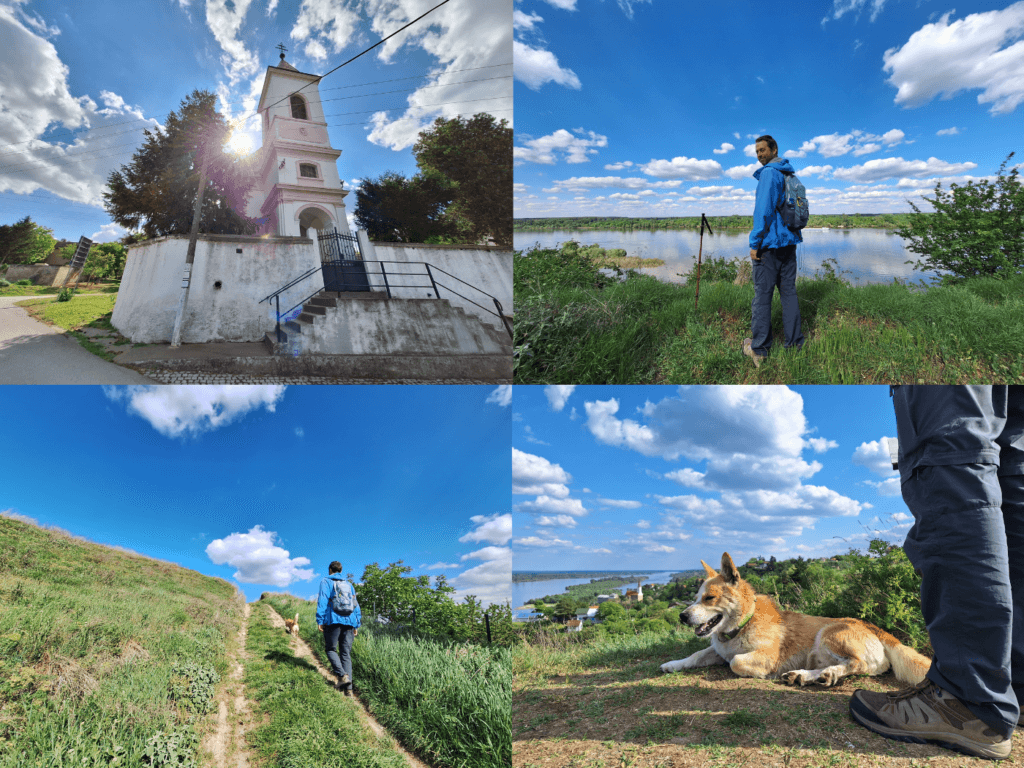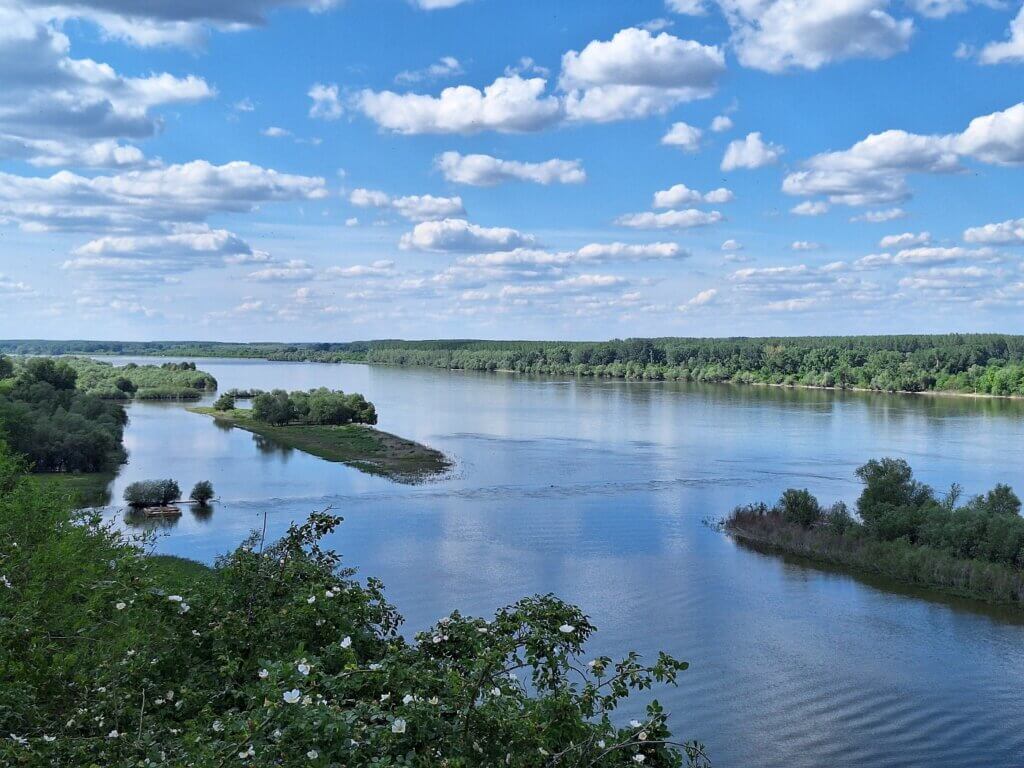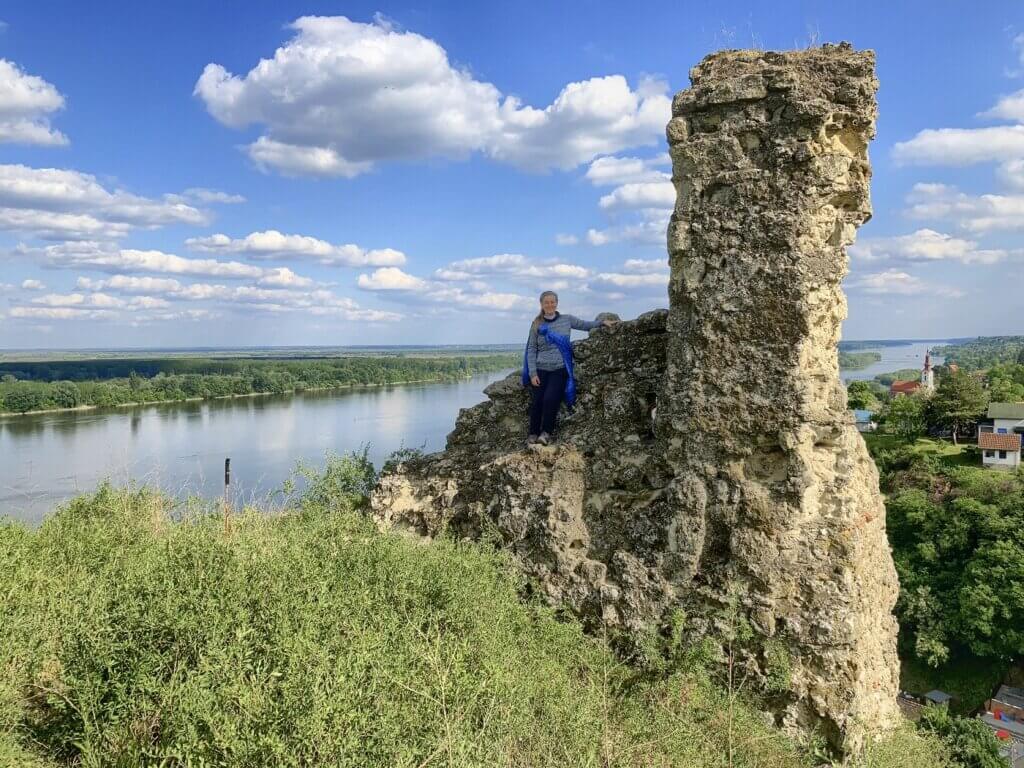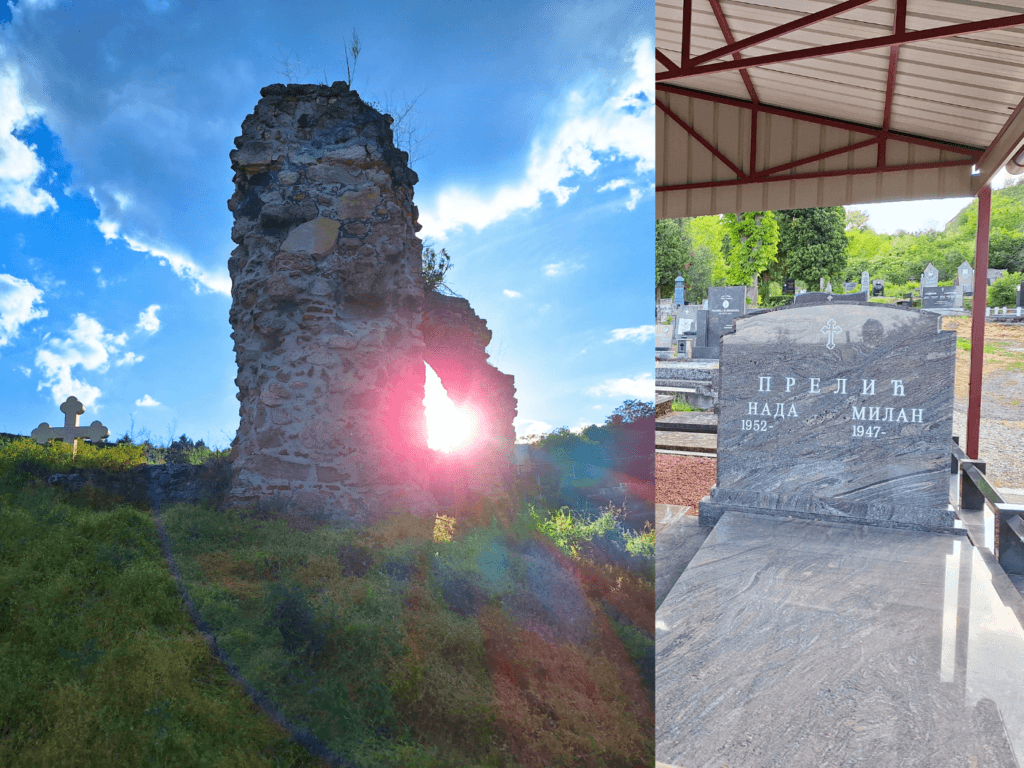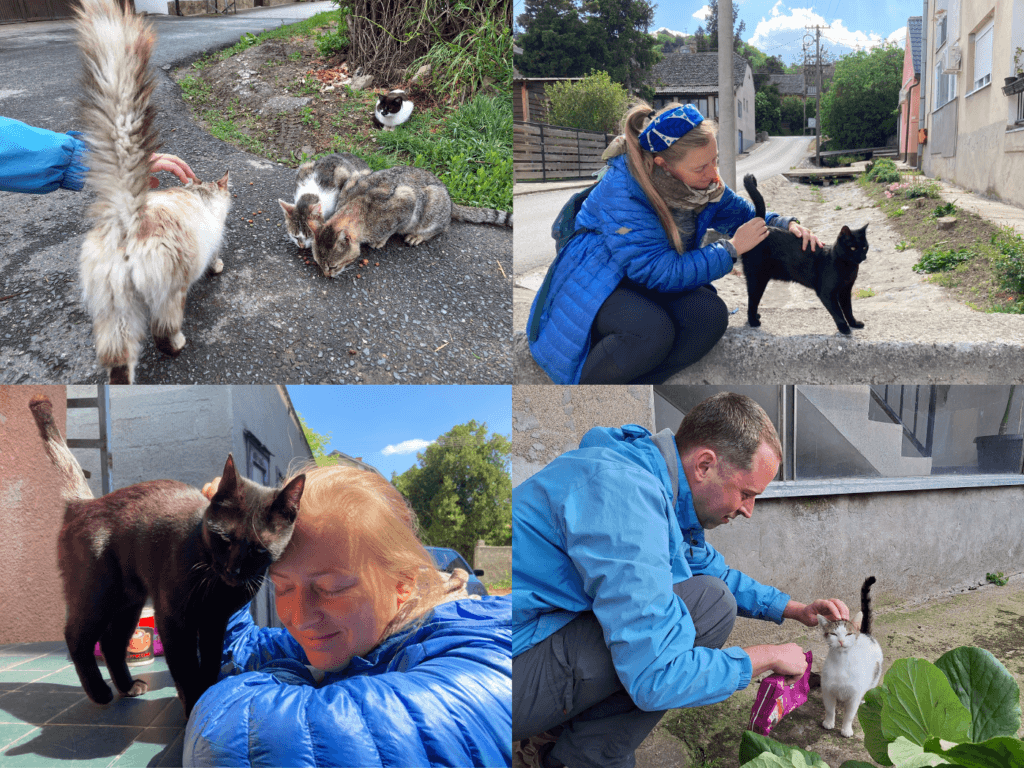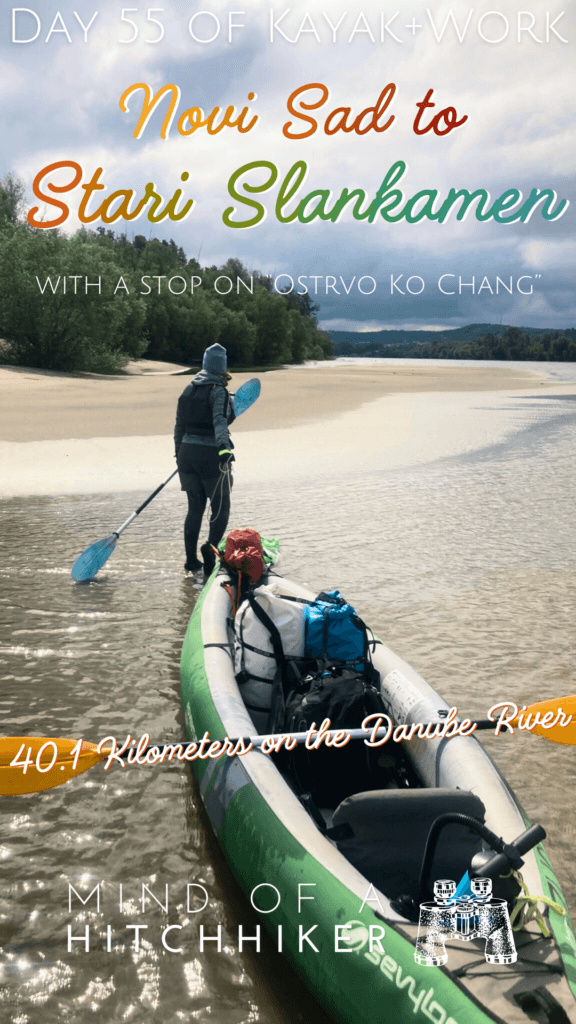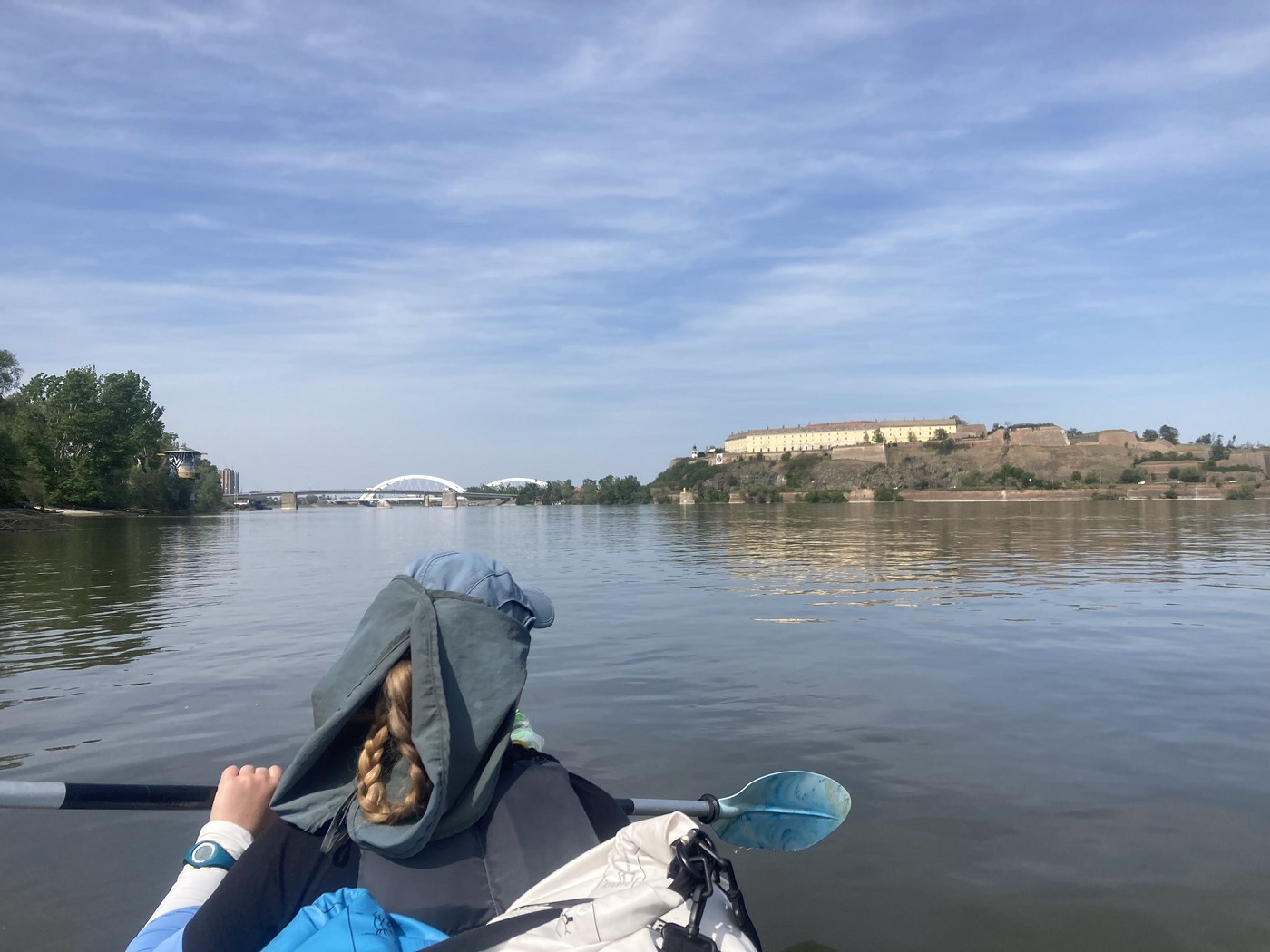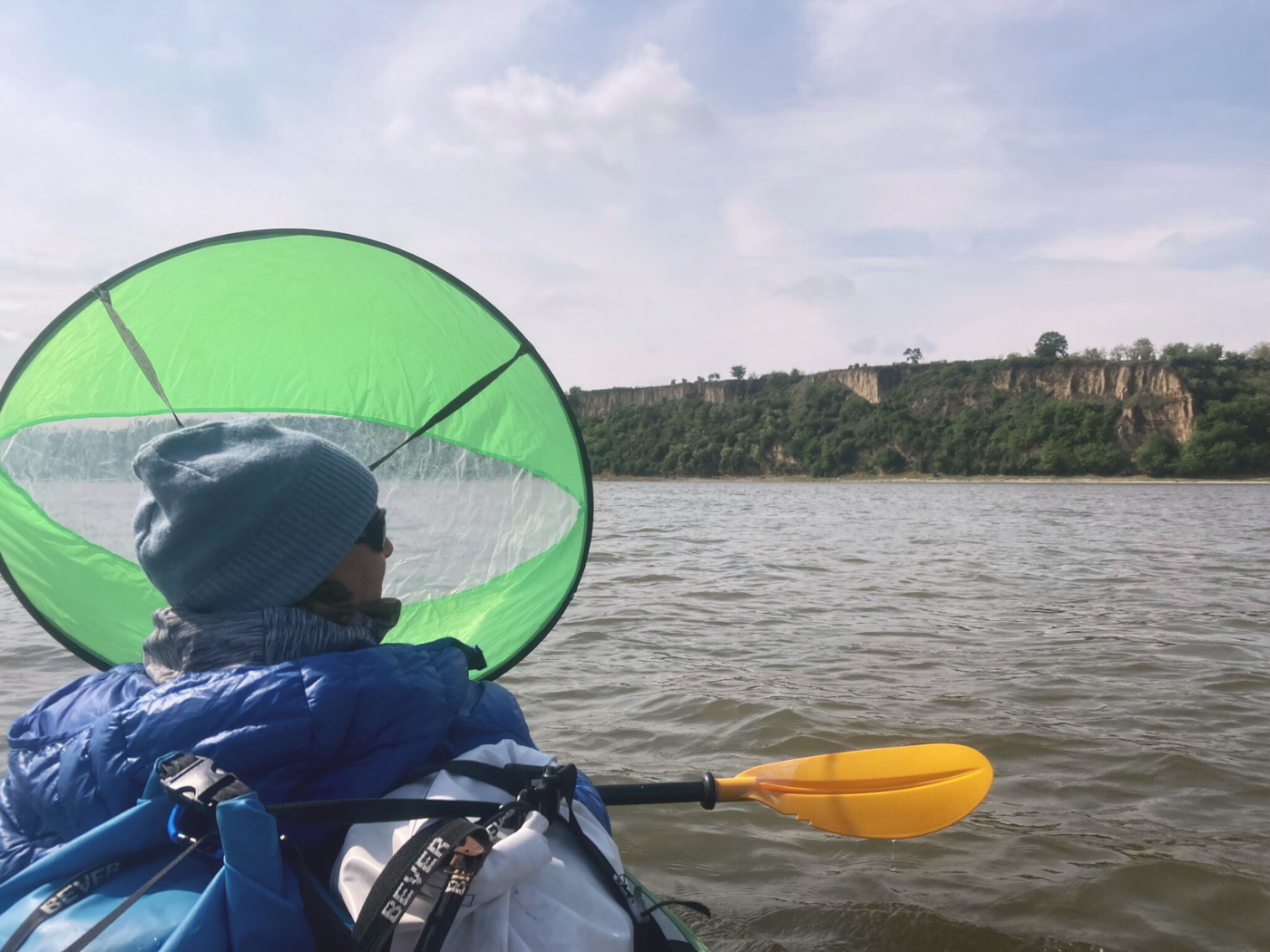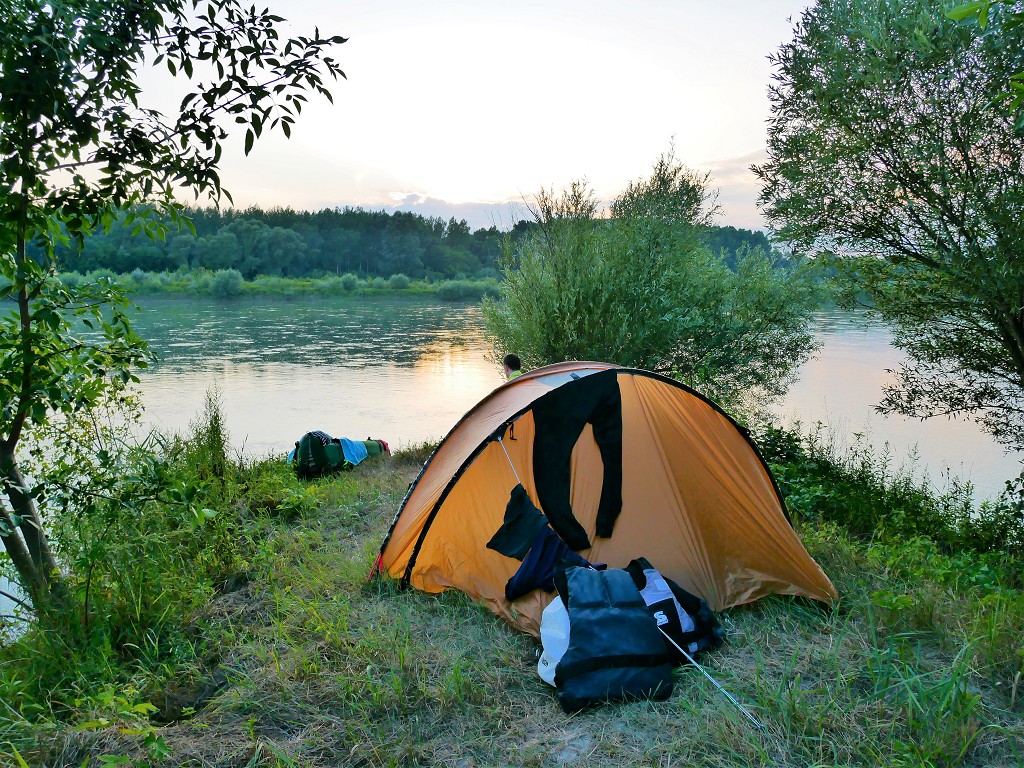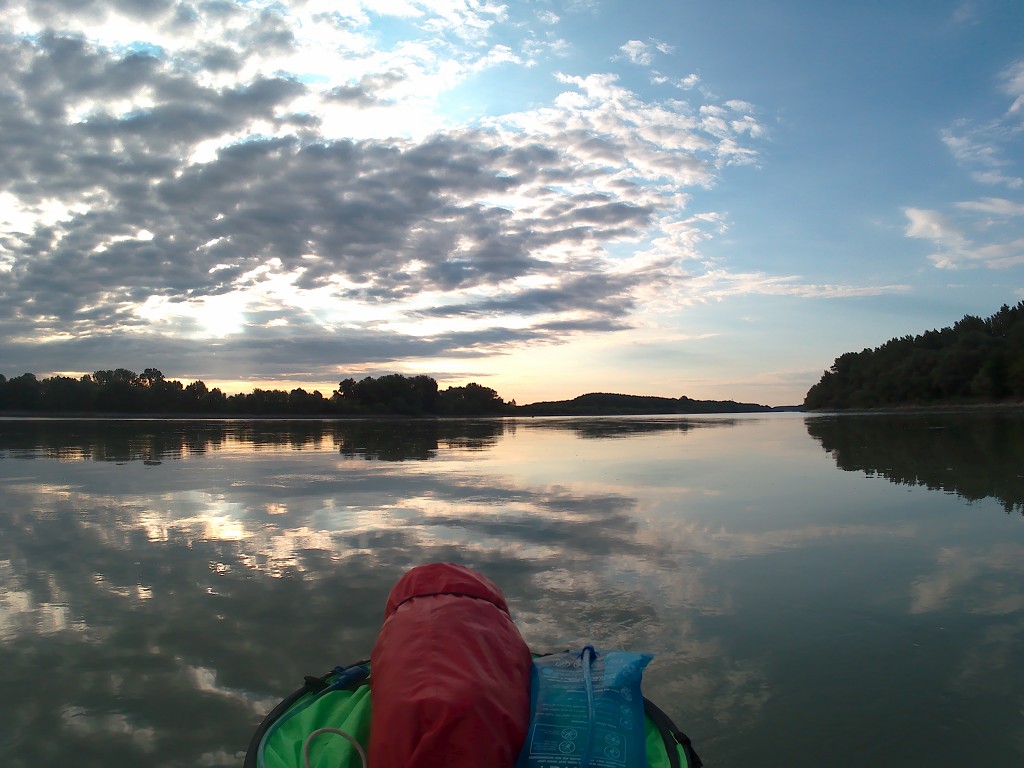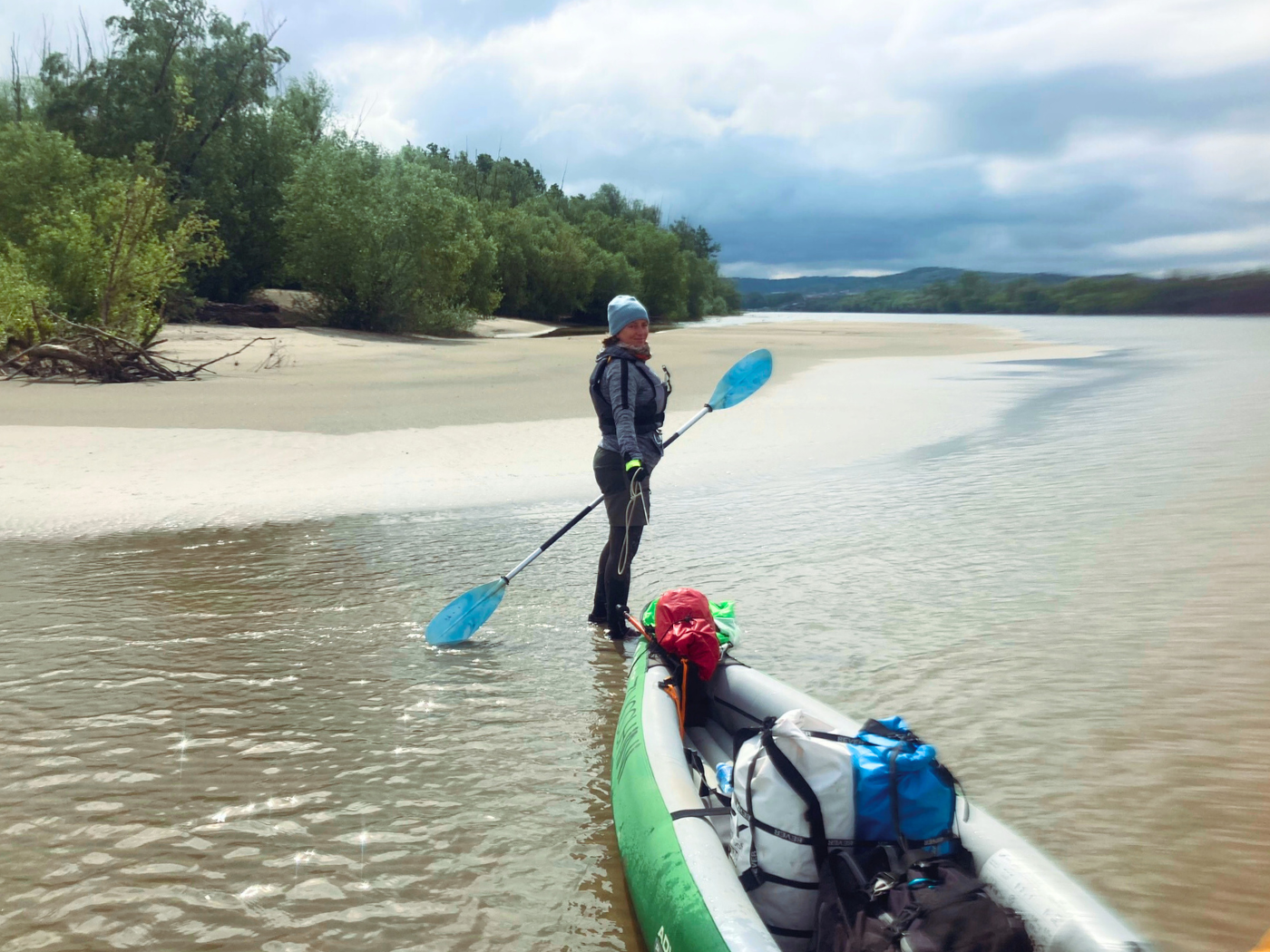
Our 55th paddle day was on Wednesday, the 17th of April, 2024. We paddled from Serbia’s second-biggest city Novi Sad to the village of Stari Slankamen. This is about 40 kilometers and it was very cold.
Want to travel the (entire) Danube River in an adventurous way? Join our Facebook group Danube River Source to Sea: Kayak / Canoe / Bike / Hike / Sail to find your community
Contents
- 1 Low Expectations
- 2 Paddling Out of Novi Sad + Novi Sad Bridges
- 3 DTD Canal + New Bridge at Kovilj + A Stop in “Ko Chang”
- 4 Sailing to Stari Slankamen + Beška Bridge
- 5 Arriving in Stari Slankamen
- 6 Our Stay in Stari Slankamen
- 7 Thanks for reading! Consider buying me a glass of wine
- 8 Good read? Feel free to share
Low Expectations
During our week in Novi Sad, we’d been keeping an eye on the weather forecast with a sense of dread. After more than a week of sunny weather, hitting above 25°C every day, a complete reversal of spring and summer was in the making. Just on Monday, we sought respite from the 31°C heat in the city by escaping to the canopy of Fruška Gora. Not even two days later, it would be a maximum of 13°C 12°C 11°C. And it would rain.
I packed my down winter jacket in my personal dry bag, along with an emergency space blanket. I would wear my winter hat and gloves and my sweater. If it’s raining at the time we leave, I’ll have my poncho nearby. It felt intimidating to do 40 kilometers on the Danube in the cold.
Because of the taxi incidents when arriving in Novi Sad, we expected a lot of fuckery again. Because Yandex Taxi worked before and we could rate the taxi drivers in such an app, we decided to give that one a try.
We waited for the heavy rain to stop. I sometimes stepped out onto the balcony to get a feeling for today’s bleak weather. We’d told our host in Novi Sad we’d leave at 8:00, but we waited till 8:30 before setting out.
Jonas requested a taxi in the app and he’d be there in two minutes. We hurried downstairs, dropped off the key in the mailbox, and walked to the vehicle. We opened the trunk and puzzled our three-and-a-half bulky items in there. The taxi driver – a young man – didn’t get out. That’s wonderful for us.
We drove off to our launch spot at the faculty of philosophy of Novi Sad University. But the street was now blocked off for maintenance work, so we had to walk the last 600 meters with all the heavy luggage. Walking down the steep embankment was a little tricky with the wet grass, but neither of us fell. The rain had stopped. We inflated Zucchini and put her in the water below Petrovaradin Fortress while a black dog was running up and down the beach.
There was this mysterious fog on the water. The Danube was warmer than the air temperature from the previous weeks of hot weather. The flow looked promising.
We set out on today’s journey to Stari Slankamen at 9:22.
Paddling Out of Novi Sad + Novi Sad Bridges
It was about 6°C when we started, but pumping up the boat had warmed us up slightly. The real feel temperature was much lower.
First, we paddled between the vacant pillars of the Former Franz Joseph Bridge destroyed by the retreating Germans in 1944. To our left, one was standing like it has done for more than 140 years. To our right, the toppled pillar lay in the water. Further to the right were upright pillars used by Great Cormorants to take up their iconic wing-spreading pose. The last pillar, closest to Petrovaradin Fortress, is the one that was dressed up as the Yellow Submarine from the Beatles for the 2022 Exit Music Festival of Novi Sad.
Soon after, we paddled under the Varadin Bridge. This location has seen many bridges, starting with pontoon bridges made of oak wood. People who weren’t citizens or transporters had to pay a toll to cross. As it was made of wood, it needed constant monitoring, maintenance, and caution when there would be ice floes on the Danube. One iteration of the pontoon bridge was the Hagen Bridge, which would open in the middle to let ships pass.
The first permanent bridge in this location was the Prince Tomislav Bridge, which was destroyed by retreating Yugoslav forces in 1941. The next bridge was the Marshal Tito Bridge, aka the Old Varadin Bridge, which was built by German POWs. That one lasted till 1999, when NATO bombed it and one civilian died. The newest and current version of the bridge opened in 2000 atop the heightened old pillars. It’s the most important bridge in Novi Sad.
The Danube turned right and we paddled past the customs and immigration station in Novi Sad. A few days ago, I’d walked there and asked the staff some questions about checking in to Serbia here with a kayak. I wrote about it in the previous article, but the short answer is: don’t try to go through Serbian immigration by kayak in Novi Sad. We were a little afraid someone would come out to stop us here, but so far, no authority stops a kayak. Also, a ship was moored at immigration, so they were busy.
Next up: the New Žeželj Bridge. It’s a rail-and-road bridge and there are supposedly also safe areas for pedestrians and cyclists. NATO also bombed and dropped this bridge in 1999, leaving Novi Sad without any Danube bridges for about a year. A temporary bridge with one lane for both rail and road was built a little further upstream. Once the New Žeželj Bridge was completed in 2018, the city dismantled the temporary bridge.
And this is where we stand today with usable Danube bridges in Novi Sad.
DTD Canal + New Bridge at Kovilj + A Stop in “Ko Chang”
A fisherman on the left bank was scouting for a good spot. The flow remained good as we turned right, but the water got dirtier and dirtier. The Danube–Tisza–Danube (DTD) Canal joined us from the left. This particular branch is still in use for navigation, judging by the map of Marine Traffic.
There are lots of ships and barges anchored on the right-hand side of the Danube, awaiting loading, unloading, or bureaucracy. Some of them look like they’ve been here a while. They’re parked impressively closely together. To our left were lots of water extraction buildings, but of the older kind.
We turned southeast and saw the construction we’d only seen on satellite view: the construction of a new Danube bridge between Kovilj on the left and Petrovaradin on the right. Google Maps calls it the Fruškogorski koridor, meaning the corridor to Fruška Gora.
This bridge is in a further state than the other bridge that’s under construction around Novi Sad’s Bulevar Evrope and Sremska Kamenica. The concrete pillar on the left side stands tall. As we approach, the voices of construction workers and the noises of welding become stronger. We paddle through the official shipping lane down the middle. I think we’ve now officially left Novi Sad.
Nature had returned to the river. Leaving the potential fuckery behind us, it was time to smash a protein bar. We were quite hungry since we started so late. I paddled first while Jonas ate. We passed some dredging ships, one stationary, one moving. We waved at the guy on the dredging ship. Then it was my turn to eat.
I wanted to land on a river island mapped as “Острво Ко Чанг” on Google Maps, meaning “Ko Chang Island” after the one in Thailand. Its real name is Karlovačka Ada as it lies in front of Sremski Karlovci. In summer, its white sandy beaches attract day trippers from the nearby town. Locals sell cold beers and juices, food, and snacks. The north side has more wilderness. The south has a safer swimming beach and more crowds.
Predictably, when you map something as Ko Chang, people will upload their holiday snaps from Thailand to the wrong Ko Chang. Jonas and I had a good giggle over the photos with Thai writing for mango and sticky rice and offers of coconut oil massages for ฿400. It seems more that the experience on this decidedly Serbian-not-Thai island is like this:
“[…] If you decide to order food, you will encounter inconvenience with an older gentleman who will try to drive you away in every possible way. My recommendation is to bring your own food or even fire up the barbecue yourself. Anyone who stays camping in the evening is attacked by mosquitoes, where neither preparations nor fire help. Everything else is beautiful and perfect for a weekend escape from the city.”
We ran aground on the north side at 10:44 (see featured photo📸), some 30 meters from the island. We hopped out of Zucchini and pulled and lifted her close to the land. Though Ko Chang was beautiful and the sun even popped out a little to show the wonderful beach, it was still fucking cold. And we only cooled down more and more as we were not in the coziness of our boat. I put on my poncho over my life vest for an extra layer of wind protection and warmth. After our little stop of 13 minutes, we dragged Zucchini out into the deeper waters and continued paddling.
Sailing to Stari Slankamen + Beška Bridge
Though we’d only paddled about 11 kilometers at this point, we were optimistic about our progress. Despite the forecast, it hadn’t rained yet. Still, it was very cold. The only option we had to stay warm was to keep paddling. As we paddled past the rest of Ko Chang, we saw that there were buildings on the island further downstream.
A cruise ship and some cargo ships traveled upstream and we dealt with their wake. As we turned more eastward, the wind came from behind. It was cooling down my neck, so I put on the hoodie of my poncho.
The train between Belgrade and Novi Sad passed by a few times on the right bank. That’s also where the tall cliffs are that would remain a pattern throughout this day, and this entire area of the Danube.
Once the wind was coming from behind strongly, I deployed the kayak sail. We kept paddling with its help and gained quite some speed. Ahead of us, we could see the right-bank ending of Beška Bridge, which looked like a very tall one.
After 12:00, we paddled past the second island I’d mapped for a potential break called Čortanovačka Ada. But we didn’t need a break and they cooled our body temperatures down too much, so we continued towards the bridge.
We were getting hungry again, but we had to wait to eat our sandwiches till after the bridge and the group of shallow islands in that area. I deployed and folded up the sail a bunch of times and paddled with it quite irregularly. When folded up, it acted a bit like a blanket for my toes, which were so cold I hadn’t felt them in a long time. Since a couple of kayak days, I’ve been giving periodic reminders to Jonas to wiggle his toes, feet, and ankles to fight stiffness.
Finally, we were on approach to the Beška Bridge. The hill behind it appeared beneath the highway bridge full of trucks and cars. I folded away the sail and we paddled towards the bridge. Turns out it’s kind of more like two bridges? The spans going in different directions have a significant gap between them. My theory at the time was that the Serbians wanted to build better bombing-proof bridges; dropping two bridges with aerial bombardment was more difficult than one.
Though NATO also bombed this bridge back in April 1999, that is not the full story. Only the upstream (southbound) bridge existed between 1975 and 1999. During the bombing, it was only damaged, not destroyed. After repairs, it reopened in July 1999. The downstream (northbound) bridge started construction in 2008 and opened in 2011. At normal water levels, there are 51 meters between the bridge and the water. Because the right bank of the Danube is so much higher than the left one, there’s an incline of 2.7%.
This is (probably) the longest bridge across the Danube at 2 kilometers and 205 meters. It’s definitely the longest bridge in Serbia.
We paddled through the arch left of the central one.
Arriving in Stari Slankamen
We were over halfway. Some 15 kilometers to go. The last stretch went slow and fast at the same time.
Fast because the clouds were very threatening. As Jonas chomped down on a sandwich while I paddled, he checked the weather. It said it might rain in one hour. So we tried to speed things up.
To our right were the shallow islands near a weekend village. When checking on satellite view as preparation for this trip, we decided against weaving through them at the risk of running aground. This area is beautiful, with lots of birds. In summer, hot air balloons float above the Danube in this area under the name ‘Serbian Kapadokya’. I’d love to do that once.
To our left, the embankment was treeless and a little depressing. I saw some horses in the distance. When we turned a bit, there was a herd of horses, including a baby horse. They were obviously curious about our presence on the water, but they were scared as well. (Edit: turns out it’s an island called Krčedinska Ada and it’s full of domesticated animals. It flooded earlier in 2024 and the animals had to be evacuated, as I remembered correctly from this video on a Dutch news website).
The current was quite good. We kept paddling on the left side until we reached the area where the Danube turns from northeast to southeast. That’s where we crossed the river unhurriedly. It wasn’t very busy here, so a quick look over the shoulder to see if there were any ships, and then we paddled through the center.
The rain started. It wasn’t much, but it was annoying. Jonas had already put on his poncho. He sent a message to our host in Stari Slankamen that we’d arrive at 15:20.
On this side of the river, we had to watch out that we didn’t paddle over any sills (speedbumps) in the water. I kept counting down the sills until Stari Slankamen. It wasn’t far from here. And that’s roughly where the Tisza River will join the Danube. But that’s for the next paddle day.
We were both surprisingly tired and uncoordinated. My theory as to why we were tired is:
- We spent the last days worrying about the taxi situation and the weather, draining our energy
- Maybe one full week of break is too much this early in the paddling journey
Still, we will spend a full week in Belgrade as well soon. Not only for my walks down memory lane and showing Jonas where I used to live, but also because there are tons of vegetarian and Indian restaurants. We crave the paneer!
The last stretch felt like it took forever, but in hindsight, it wasn’t all so tediously slow. We spotted Stari Slankamen and its first harbor for small boats. Jonas said we could land before the sill that’s at the beach in Stari Slankamen. I was like “Are you sure?” but he was already paddling us in that direction. It was a soft landing on the beach, dodging something in the water at the very last minute.
Yay! We arrived in Stari Slankamen! Another 40 kilometers done. Time: 15:16.
I dealt with the boat and most of the luggage while Jonas walked with the dry bags to our accommodation. It was just the building next to the beach, according to the coordinates we received from Booking.
I didn’t feel my toes. I took off my water shoes, dried my feet just a little, then put on my socks. Since the rain stopped, I also put on my down jacket to warm up. This helped immensely.
Jonas messaged me that it was the wrong location. He eventually went to the right place, checked in, and received the house tour. He came back a while later when I had already packed up everything except Zucchini. She wasn’t going to dry in this weather anyway, so we packed her up and walked to the apartment. There was a goat herder with many small goats right after Stari Slankamen’s rather nice beach.
The apartment was three flights of stairs up, but man was it worth it! The views of the Danube are incredible. I used this as my working spot during the four nights we stayed in Stari Slankamen.
I only got the feeling back in my toes when I took a nice hot shower.
Our Stay in Stari Slankamen
This is how we spent our four nights in Stari Slankamen:

